Cage birds, also known as pet birds, are birds that are kept in captivity as pets. Some people enjoy the companionship and beauty of a caged bird, while others appreciate the unique personalities and intelligence of some species.
The selection of a caged bird can depend on many factors, such as the owner’s lifestyle, living space, and experience with birds. Many different species of cage birds have become popularized over the years, each with their unique characteristics and needs.
This article will explore some of the most popular cage birds and their unique features.
1. Rock Dove
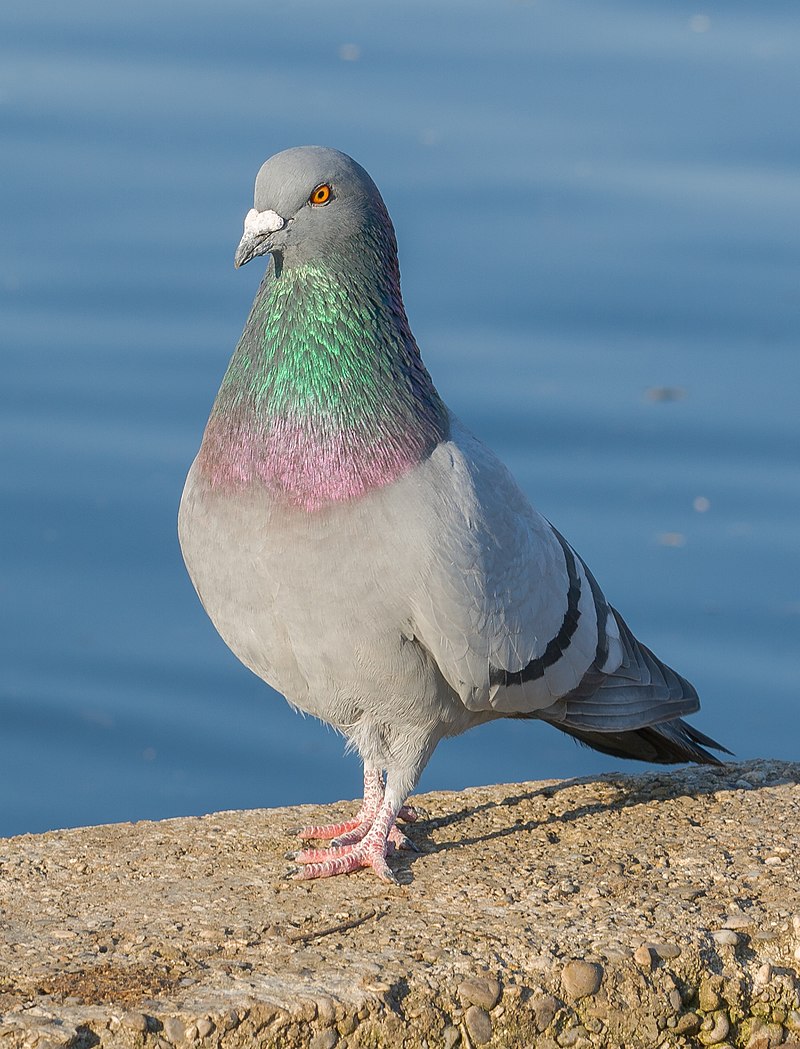
Rock dove, also known as Rock Pigeon or Common Pigeon, is a member of the bird family Columbidae.
It is considered to be an important creature worldwide due to its domestication by humans centuries ago; resulting in the modern-day Domestic pigeon which descends from this species.
Its population has increased over time because some domestic pigeons have escaped captivity and joined wild populations.
The rock dove can most easily be identified by its prominent blue-grey feathers with darker bars on the wings and tail along with two black bands on each wing.
They are typically found in large flocks near cliffs or buildings but may also inhabit rural habitats such as open fields and meadows if there’s enough food available for them nearby.
Although they don’t migrate far distances like other birds, their numbers increase significantly during winter months.
When more food sources become available they won’t need to travel too far away from their home base for nourishment.
Scientific classification:
| Kingdom | Animalia |
| Phylum | Chordata |
| Class | Aves |
| Order | Columbiformes |
| Family | Columbidae |
| Genus | Columba |
| Species | C. livia |
Also Featured In: Common Birds in India, Common Birds in the Cities
2. Rose-Ringed Parakeet
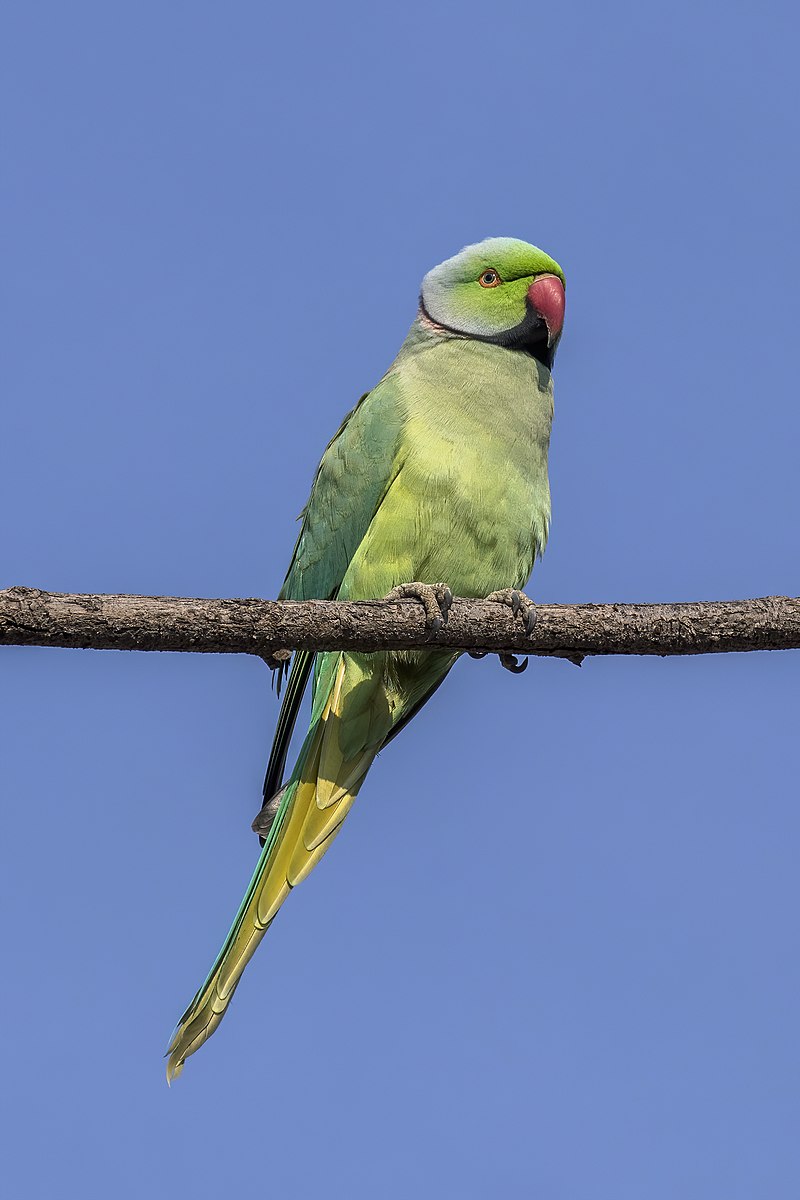
The Rose-ringed parakeet is a medium-sized bird in the family Psittacidae. Native to Africa and India, it has been introduced into many other parts of the world where feral populations have now established themselves.
The most distinctive feature of this species is its colorful neck ring ranging from pink to purple which gives them their name.
However, males often display more vibrant colors than females do. This beautiful bird can also imitate human speech quite well making them popular pets worldwide.
In addition, they are very social creatures preferring large flocks when out in nature or as part of aviaries during captivity. With proper care, these birds can live up to 30 years.
Scientific classification:
| Kingdom | Animalia |
| Phylum | Chordata |
| Class | Aves |
| Order | Psittaciformes |
| Family | Psittaculidae |
| Genus | Psittacula |
| Species | P. krameri |
Also Featured In: Common Birds of Mumbai, Common Birds in London
3. Finches
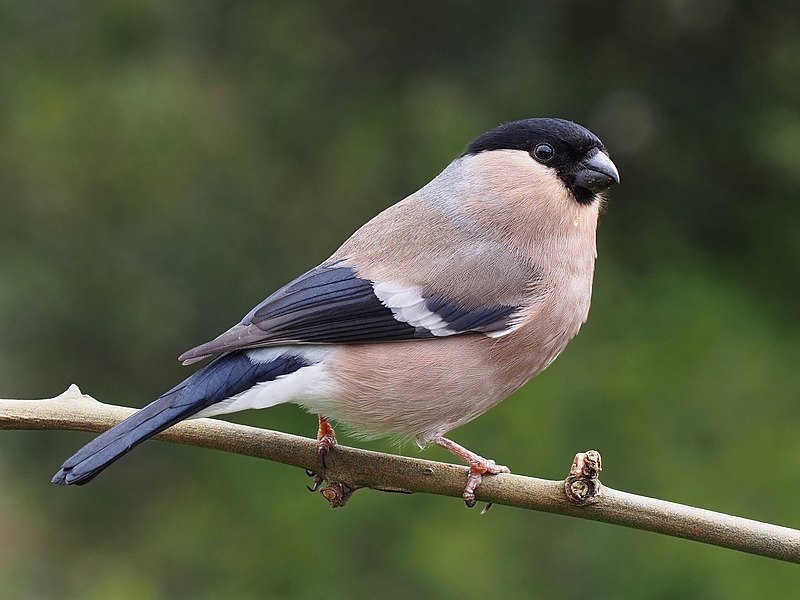
Finches are a diverse group of passerine birds found around the world, excluding Australia and polar regions. They vary in size from small to medium-sized, with stout conical bills adapted for eating seeds and nuts.
Many species have brightly coloured plumage; this helps them stand out against their natural habitats which can range from deserts to forests.
Finches occupy these areas all year round without migrating elsewhere – making them particularly well suited for local environments.
As part of the Fringillidae family, they possess unique characteristics that make them popular amongst birdwatchers everywhere.
Scientific classification:
| Kingdom | Animalia |
| Phylum | Chordata |
| Class | Aves |
| Order | Passeriformes |
| Superfamily | Passeroidea |
| Family | Fringillidae Leach, 1820 |
Also Featured In: Native Pakistani Birds, Most Common Winter Birds
4. Hyacinth Macaw
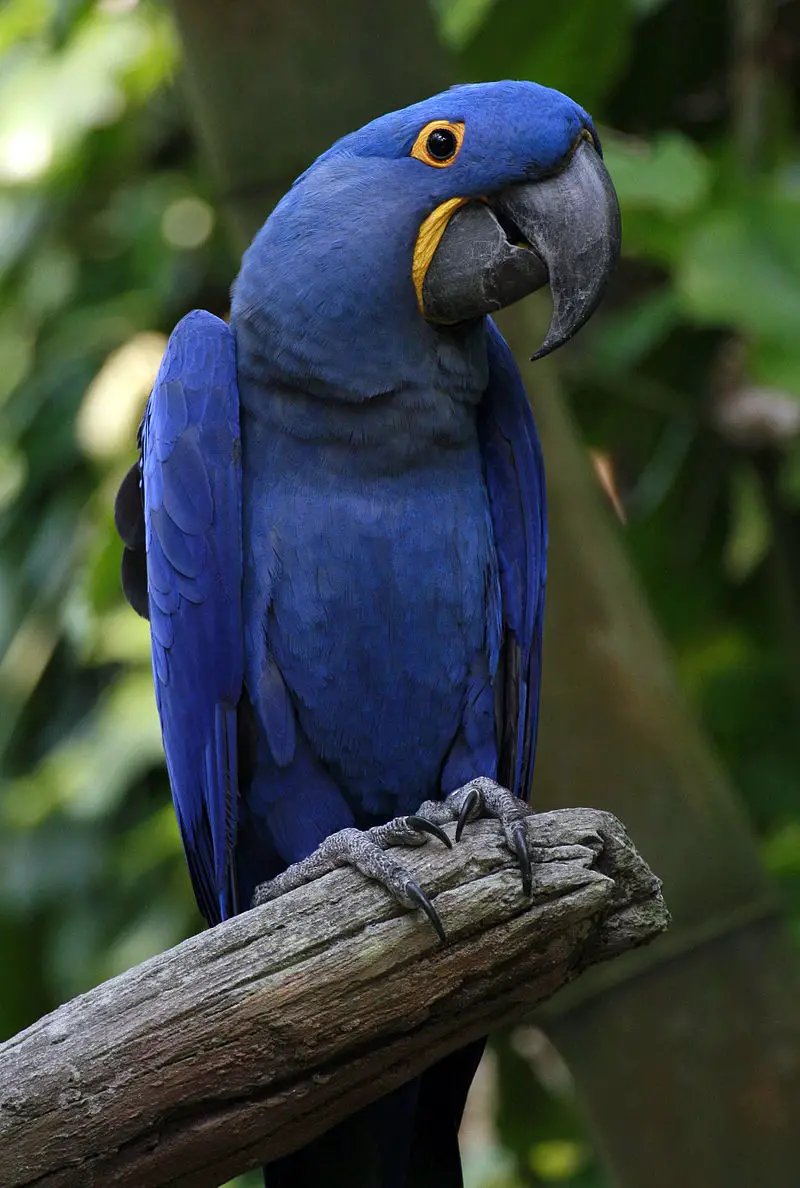
The Hyacinth Macaw is an extraordinary bird, known for its impressive size and vibrant coloration.
It has a length of around one meter, making it the longest parrot species in existence as well as the largest flying parrot species; even larger than the 3.5 kg flightless Kākāpō from New Zealand.
Its striking blue plumage with yellow at its wingtips gives this majestic bird an eye-catching appearance that’s sure to turn heads wherever it goes.
Native to central and eastern South America, these birds are highly intelligent creatures who form strong bonds with their owners when kept in captivity.
They make great companions if given proper care and attention which includes providing them with plenty of space for exercise and enrichment activities such as playtime out of the cage on occasion or teaching them tricks using positive reinforcement methods like verbal praise or food rewards.
Scientific classification:
| Kingdom | Animalia |
| Phylum | Chordata |
| Class | Aves |
| Order | Psittaciformes |
| Family | Psittacidae |
| Genus | Anodorhynchus |
| Species | A. hyacinthinus |
Also Featured In: Beautiful Brazilian Birds, Birds That Live in the Jungle
5. Scarlet Macaw
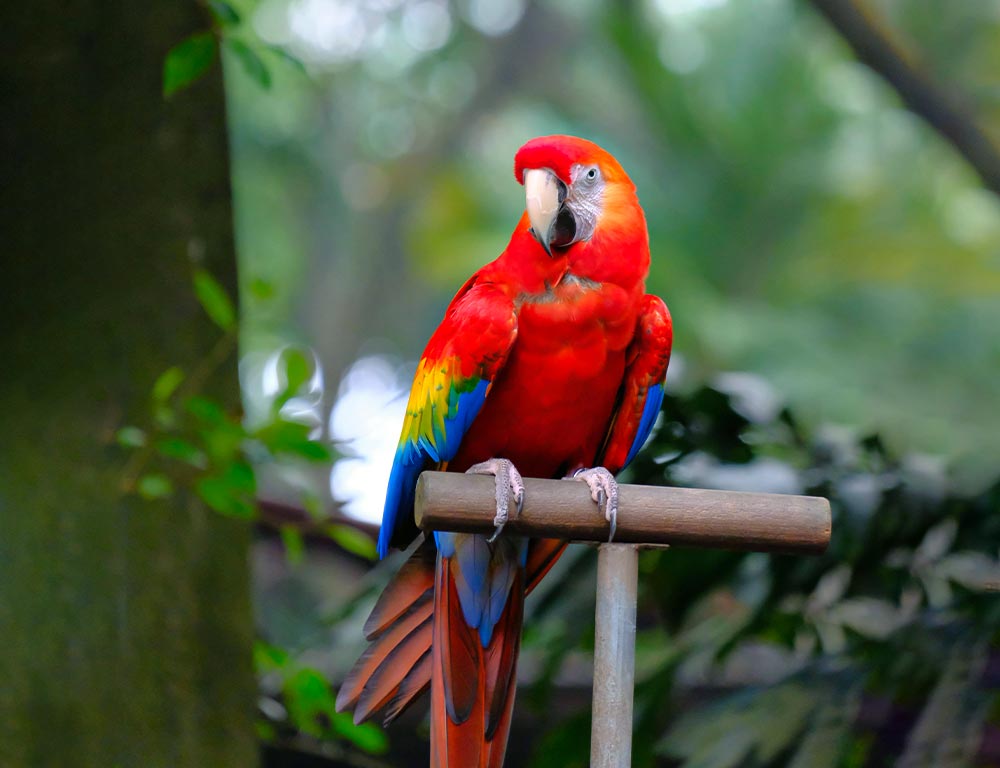
The Scarlet Macaw is a vibrant and beautiful bird found in Central and South America. Its striking red, yellow, and blue feathers make it stand out among other parrots.
It inhabits humid evergreen forests of the Neotropics from Mexico to Peru, Ecuador, Colombia, Bolivia Venezuela Brazil up to an altitude of 1000m (3300ft).
These birds have strong beaks which they use for breaking open hard nuts or seeds that would otherwise remain inaccessible.
They also form social bonds with their mates by grooming each other’s feathers and engaging in playful activities such as chasing one another around tree trunks.
Despite its vivid colors, the Scarlet Macaw remains vulnerable due to habitat loss caused by deforestation so conservation efforts are essential if this amazing species is going to survive for future generations.
Scientific classification:
| Kingdom | Animalia |
| Phylum | Chordata |
| Class | Aves |
| Order | Psittaciformes |
| Family | Psittacidae |
| Genus | Ara |
| Species | A. macao |
Also Featured In: Most Common Birds in South America Birds, Common Tropical Rainforest Birds
6. Blue-and-yellow Macaw
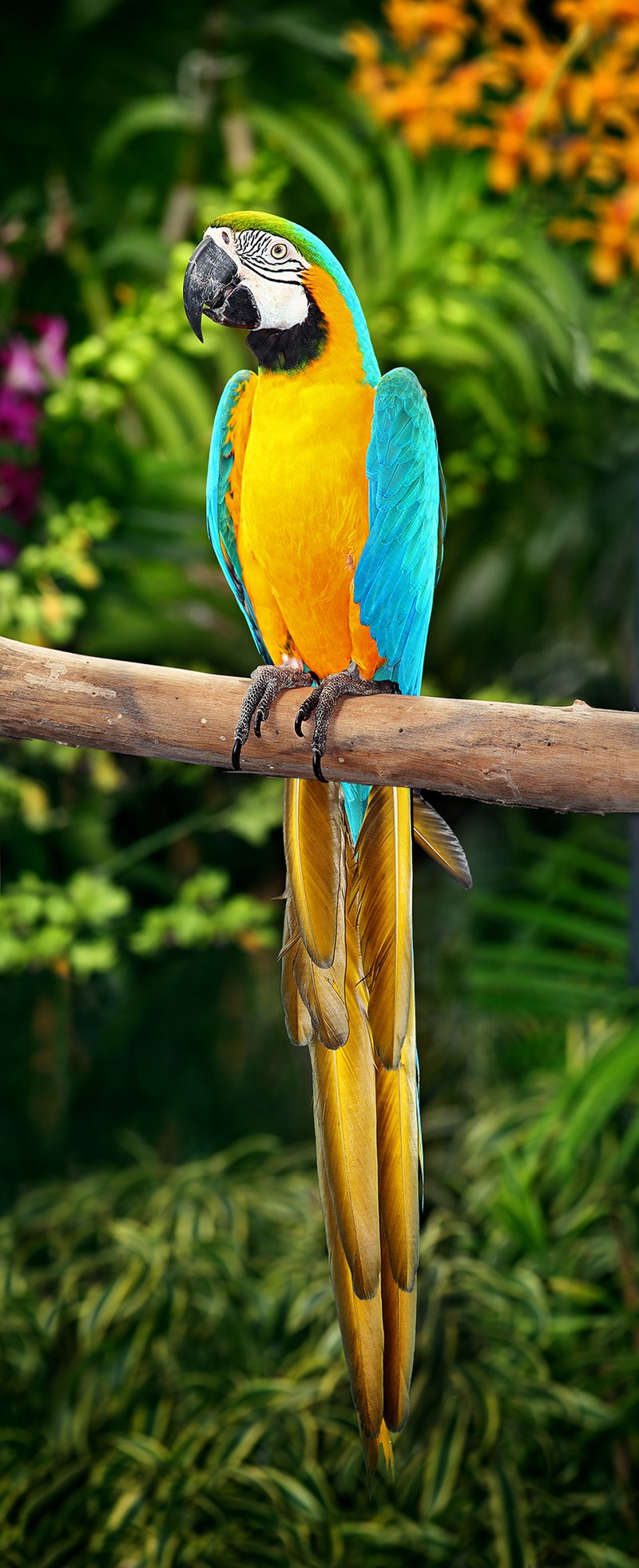
The Blue-and-yellow Macaw is a vibrant and eye-catching bird native to South America. It has beautiful blue top parts, light orange underparts, and green on its head.
This large parrot lives in the tropical forests of varzea, terra firme, or unflooded forest areas.
They are social birds that live in small flocks which can range from two to twenty birds during breeding season when they look for mates.
They feed mainly on seeds, nuts, and fruits but sometimes also eat insects like beetles and caterpillars as well as tender shoots from trees & plants.
These macaws have an impressive call with screams used both to attract mates and communicate between members of their flock while flying long distances across open fields together.
Scientific classification:
| Kingdom | Animalia |
| Phylum | Chordata |
| Class | Aves |
| Order | Psittaciformes |
| Family | Psittacidae |
| Genus | Ara |
| Species | A. ararauna |
Also Featured In: Birds You’ll Find in Zoo,
7. Passerine
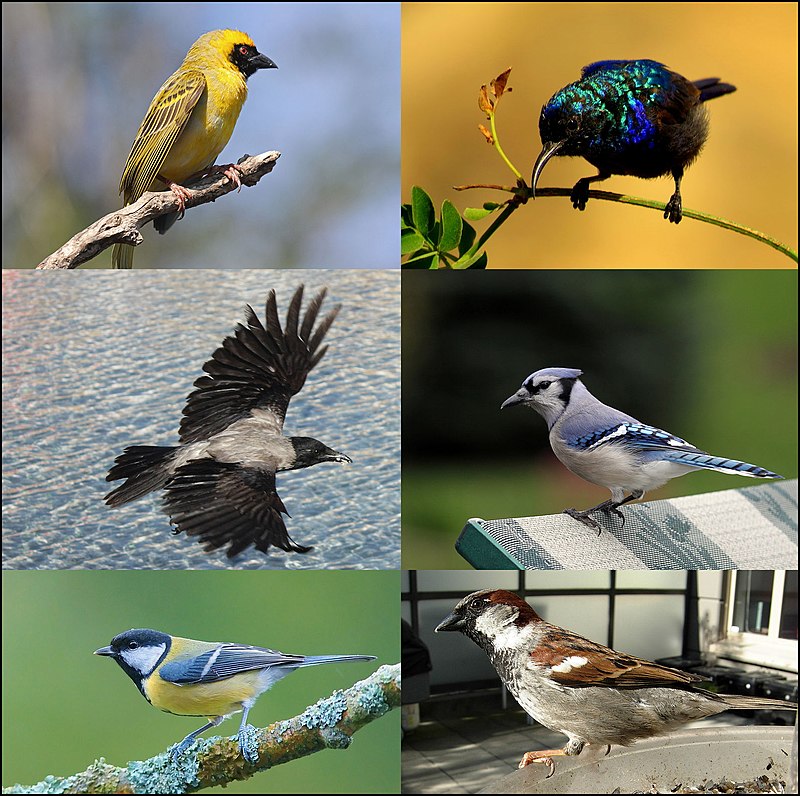
Passerines are a vast order of birds, comprising more than half the species in existence. Many familiar garden and woodland species fall into this category such as sparrows, blackbirds, finches, and warblers.
They can be recognized by their arrangement of toes; three pointing forward with one back which helps them perch on branches or wires.
Passerines range from tiny wrens to large crows and have adapted to inhabit many environments around the world including forests, mountainsides, and deserts.
They feed mainly on insects but some also consume fruit and seeds depending on their diet preferences.
Their diversity is truly remarkable from vibrant colored tropical parrots to drab winter thrushes – making passerine birds an integral part of our natural heritage.
Scientific classification:
| Kingdom | Animalia |
| Phylum | Chordata |
| Class | Aves |
| Clade | Psittacopasserae |
| Order | Passeriformes Linnaeus, 1758 |
Also Featured In: Egyptian Birds, Most Common Songs Birds that Live around You
8. Parrots
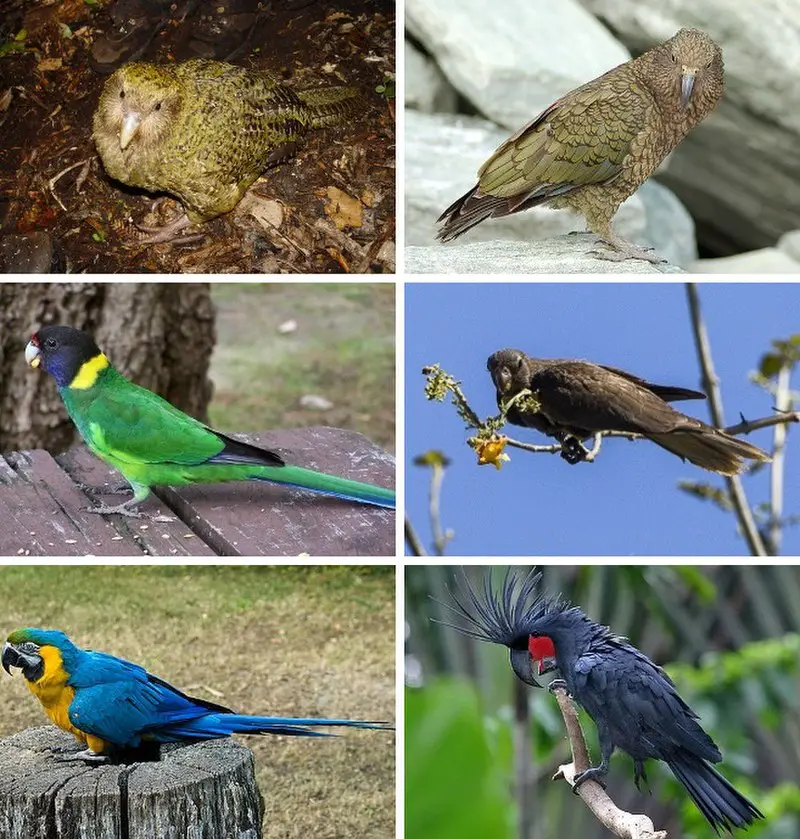
Parrots are a diverse group of birds, found in tropical and subtropical regions. They make up the order Psittaciformes, which is divided into three superfamilies: “true” parrots (Psittacoidea), cockatoos (Cacatuoidea) and New Zealand Parrots (Strigopoidea).
Many species have brightly colored feathers that can be red, yellow, or blue. Their strong curved bills allow them to feed on fruits, nuts, and seeds.
Parrot behavior ranges from playful to aggressive depending on their environment and socialization with humans.
Some even learn human words. As beloved pets, they bring joy to many households around the world though it’s important for owners to understand how best to care for these intelligent creatures so as not to cause distress or harm.
Scientific classification:
| Kingdom | Animalia |
| Phylum | Chordata |
| Class | Aves |
| Clade | Psittacopasserae |
| Order | Psittaciformes Wagler, 1830 |
Also Featured In: Most common birds in Australia, Famous Paintings Birds
9. Cockatoos
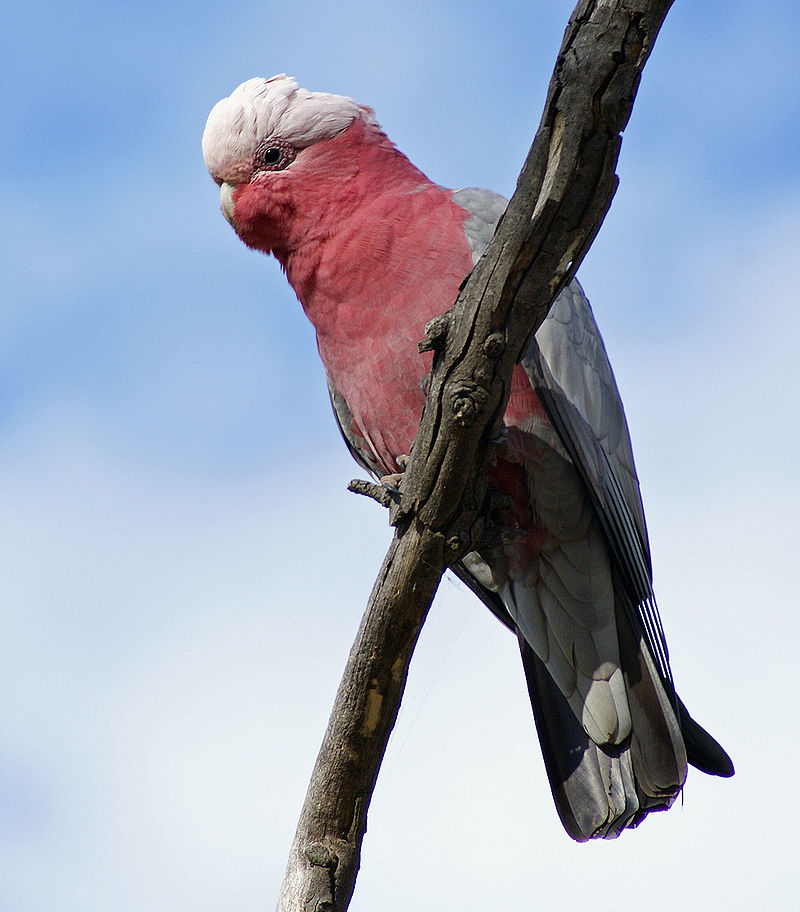
Cockatoos are a family of parrots native to Australasia. They have distinctive crests, curved beaks, and loud calls that can easily be heard from long distances.
Most cockatoo species are highly socialized and form large flocks in the wild for protection against predators or extreme weather conditions.
Cockatoos come in various sizes, with some reaching up to 90 cm (35 inches) tall from head to tail tip.
The plumage on their wings is also incredibly vibrant and they often display beautiful patterns such as stripes or spots across their feathers.
Their diet consists mainly of seeds, nuts, fruits & vegetables but they will occasionally hunt insects as well.
In captivity, these birds require lots of attention if kept as pets; however, when given proper care they can make loyal companions who love interacting with people throughout the day.
Scientific classification:
| Kingdom | Animalia |
| Phylum | Chordata |
| Class | Aves |
| Order | Psittaciformes |
| Superfamily | Cacatuoidea |
| Family | Cacatuidae G. R. Gray 1840 |
10. Budgerigar

The Budgerigar is a small and beautiful parrot, commonly known as the common parakeet or shell parakeet. It has an average length of 18 cm with a long tail and primarily green-yellow coloration along its body.
Black stripes can be found on their wings and cheeks while they have white rings around their eyes giving them a unique look.
These birds are mainly seed eaters but also love fruits, vegetables, nuts, and other grains in captivity.
They are highly social creatures that live in large flocks in the wild but enjoy companionship when kept as pets too.
Their ability to mimic human speech makes them great conversation partners for those living alone who need some company.
Scientific classification:
| Kingdom | Animalia |
| Phylum | Chordata |
| Class | Aves |
| Order | Psittaciformes |
| Family | Psittaculidae |
| Subfamily | Loriinae |
| Tribe | Melopsittacini |
| Genus | Melopsittacus Gould, 1840 |
| Species | M. undulatus |
Also Featured In: Small Birds that Live in New South Wales, Green Birds Commonly Found in Florida
11. Gouldian Finch
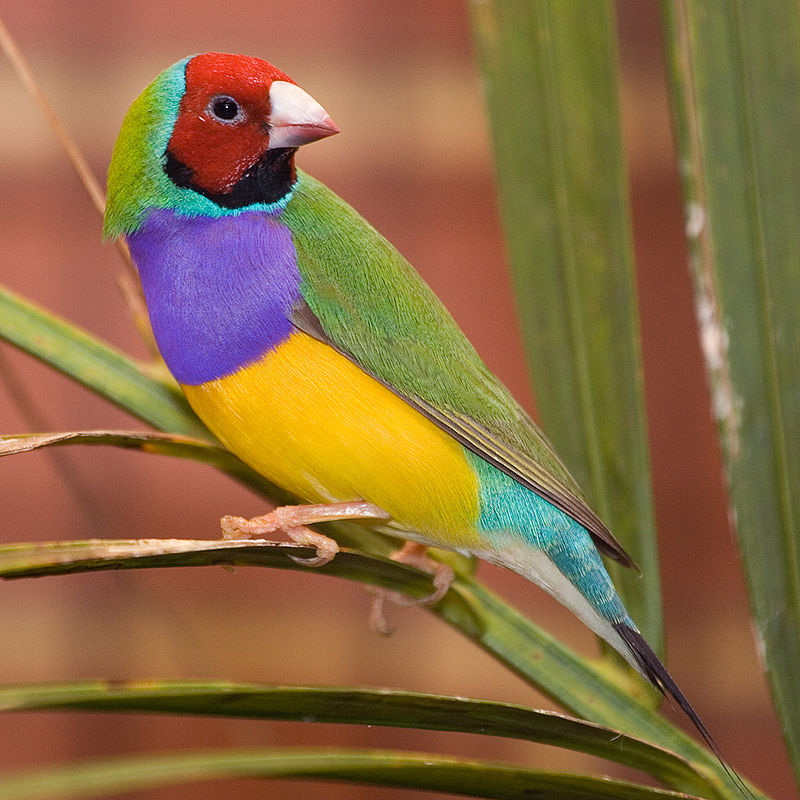
The Gouldian Finch, also known as the Lady Gouldian finch or Rainbow Finch, is a beautiful passerine bird native to Australia.
It was first described by British ornithological artist John Gould in 1844 and named after his late wife Elizabeth.
The specimens were sent to him by Benjamin Bynoe who collected them from Northern Australia.
These birds are loved for their vibrant colors which can range from yellow-green at its chest and head, purple on its wings and back with black stripes along the neckline down to some shades of blue around the tail feathers.
They feed mainly on grasses seeds but they may also eat insects when available. This species is critically endangered due mostly to habitat loss so special attention must be taken in order to preserve this unique creature’s future existence.
Scientific classification:
| Kingdom | Animalia |
| Phylum | Chordata |
| Class | Aves |
| Order | Passeriformes |
| Family | Estrildidae |
| Genus | Chloebia Reichenbach, 1862 |
| Species | C. gouldiae |
12. Cockatiel
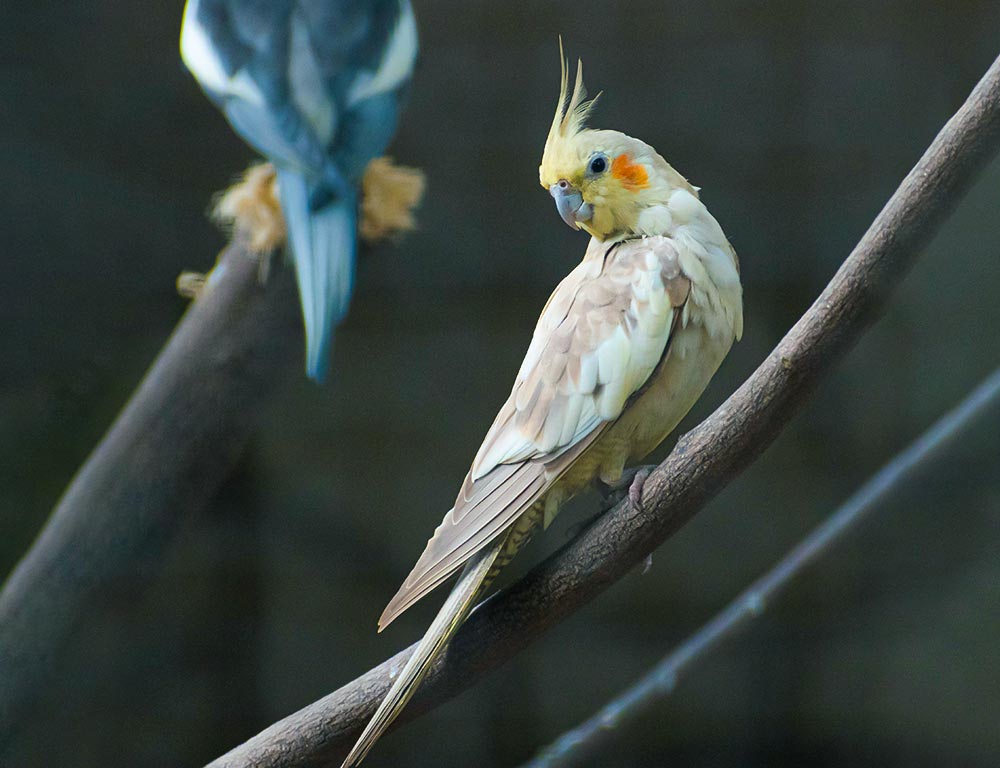
Cockatiels are medium-sized parrots that are native to Australia and make popular pets around the world.
They have an endearing personality, making them ideal companions for bird owners of all ages.
Cockatiels can be taught tricks, they love interacting with people, and many enjoy being handled as well.
These birds also have beautiful plumage in shades of yellow, white, and grey which makes them even more desirable as pet birds.
Their diet should include fresh fruits & veggies along with high-quality seeds or pellets specially formulated for cockatiel’s needs.
With proper care, these clever little parrots can live up to 15 years so it’s important to provide them with lots of love and attention.
Scientific classification:
| Kingdom | Animalia |
| Phylum | Chordata |
| Class | Aves |
| Order | Psittaciformes |
| Family | Cacatuidae |
| Subfamily | Nymphicinae |
| Genus | Nymphicus Wagler, 1832 |
| Species | N. hollandicus |
Also Featured In: Birds that Live around Victoria,
13. Rosellas
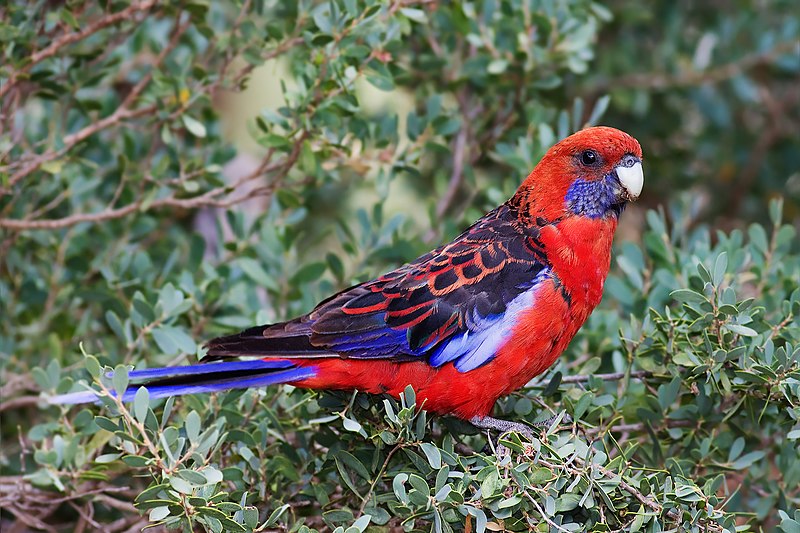
Rosellas are beautiful, colorful parrots native to Australia that belong to the genus Platycercus. They have broad tails and a diet consisting mainly of seeds and fruit.
There are six species with 19 subspecies in total. Their bright plumage is one of their most distinctive features, making them popular among bird enthusiasts around the world.
Rosellas can be seen perched on tree branches or flying freely through woodlands across much of Australia’s eastern coast as well as Tasmania’s southwestern regions.
Many people enjoy having rosellas as pets due to their attractive colors and lively personalities.
Scientific classification:
| Kingdom | Animalia |
| Phylum | Chordata |
| Class | Aves |
| Order | Psittaciformes |
| Family | Psittaculidae |
| Tribe | Platycercini |
| Genus | Platycercus Vigors, 1825 |
Also Featured In: Red Birds that Found in the United States America,
14. Barred Parakeet
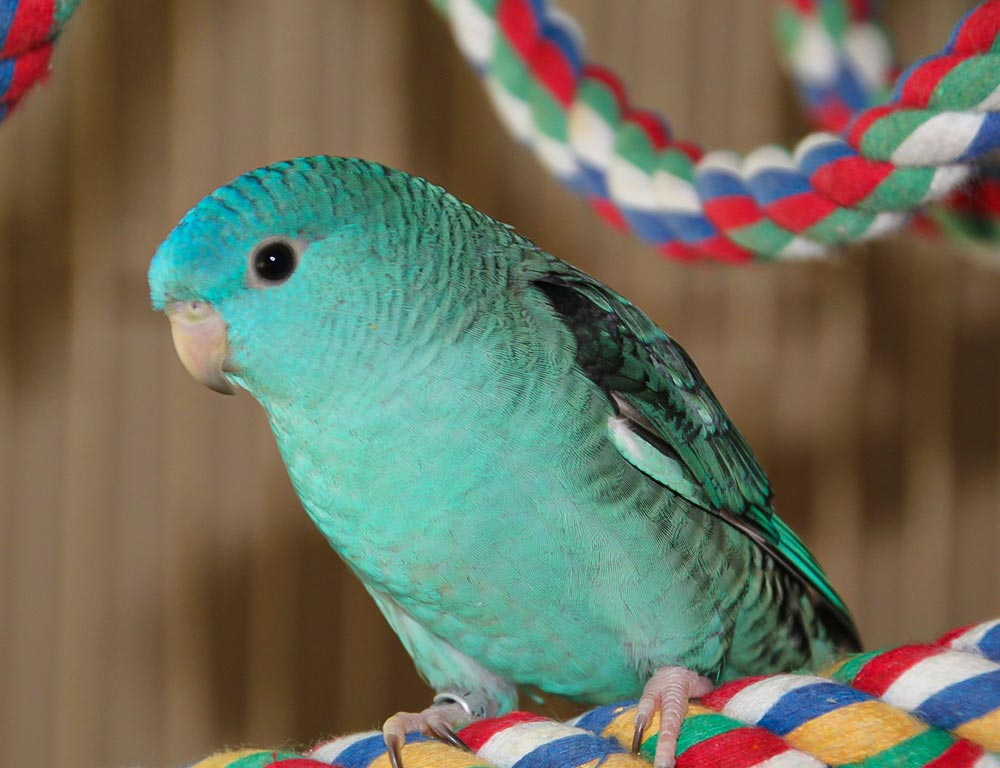
The Barred Parakeet is a vibrant and lively bird, commonly found in the highland forests of Mexico to Panama. It has beautiful green plumage with black and dark green stripes running down its body.
Its distinctive long tail feathers have white tips that contrast nicely against its green background coloration.
Besides being an attractive species, it’s also active during the day, making short flights between trees or close to the ground foraging for food.
It feeds on fruits, nuts, and other vegetation such as leaves and buds from various shrubs and trees which makes them important seed dispersers in their habitat range.
This adaptable parrot can be spotted in open woodlands as well as humid montane forests where they often flock together with other birds like macaws or toucans.
Scientific classification:
| Kingdom | Animalia |
| Phylum | Chordata |
| Class | Aves |
| Order | Psittaciformes |
| Family | Psittacidae |
| Genus | Bolborhynchus |
| Species | B. lineola |
Also Featured In: Most Beautiful Birds in Guatemala, Green Birds in That Live in Texas
15. Senegal Parrot
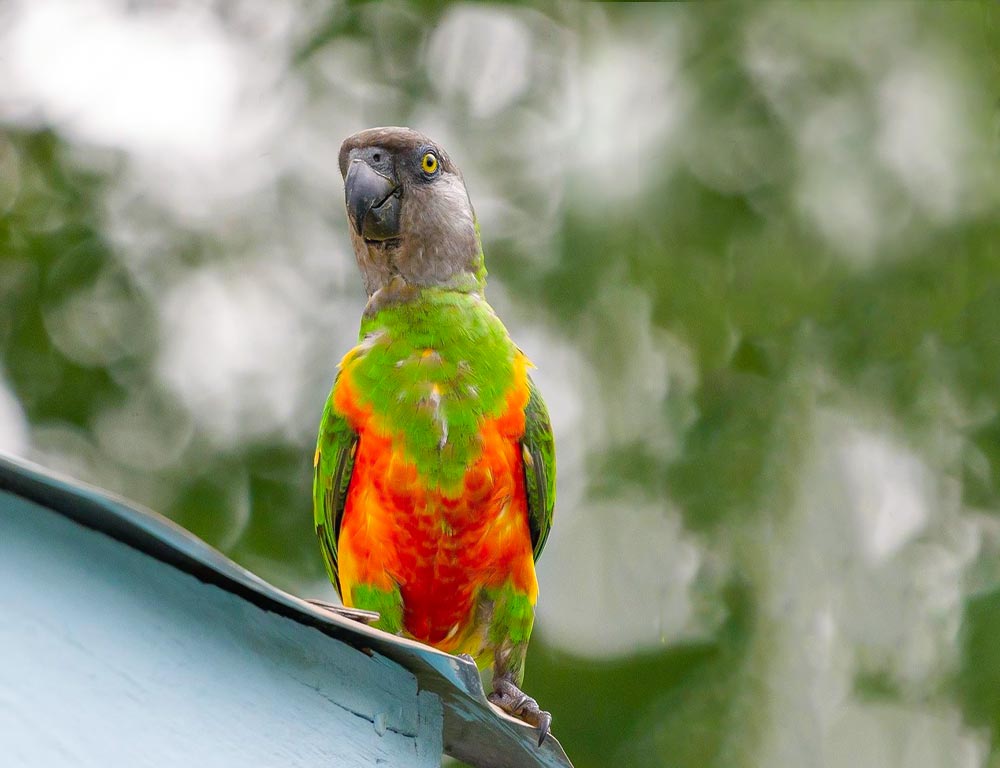
The Senegal Parrot is a resident breeder across West Africa, known for making migrations according to the availability of its diet. This mainly consists of fruit, seeds, and blossoms.
Unfortunately, it has become quite the farm pest in Africa due to feeding on maize or millet crops.
Despite this, however, it remains popular among aviculture enthusiasts worldwide as an attractive pet bird that can learn tricks easily and mimics sounds well.
It was first described by French zoologist Mathurin Jacques Brisson in 1760 with some subspecies also being recognized since then leading up until today’s modern understanding of them all together.
Scientific classification:
| Kingdom | Animalia |
| Phylum | Chordata |
| Class | Aves |
| Order | Psittaciformes |
| Family | Psittacidae |
| Genus | Poicephalus |
| Species | P. senegalus |
Also Featured In: Birds of Senegal,
16. Poicephalus
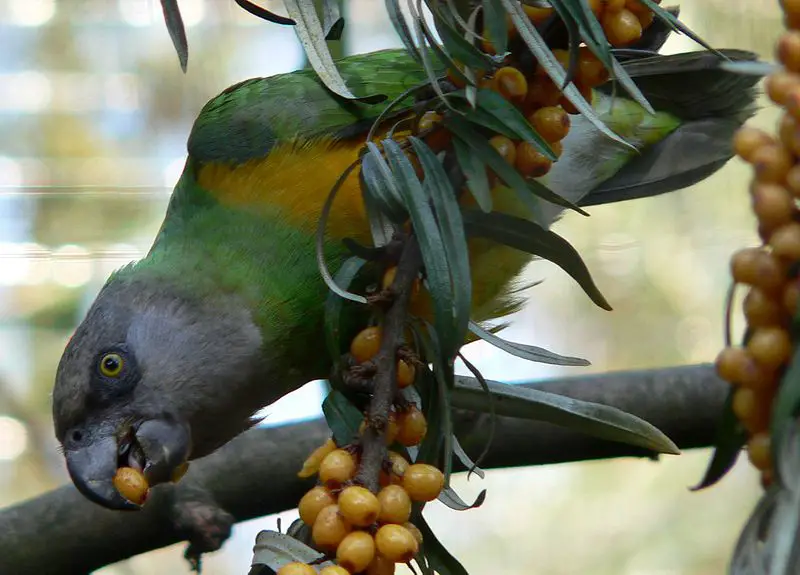
Poicephalus is a genus of parrots native to Sub-Saharan Africa that belongs to the subfamily Psittacinae. It comprises ten species which are found from Senegal in West Africa down to South Africa.
These birds have short tails and mainly green plumage, with some species having different colors such as yellow or blue on their breast and wing feathers.
They are mostly medium-sized (around 10 inches) but can vary depending on the species, ranging from 6 – to 15 inches long.
Poicephalus parrots tend to be very active and social animals, making them great pets for people who enjoy spending time interacting with their feathered friends.
They require daily stimulation through playtime, cuddles, toys or even talking sessions so they can stay mentally engaged throughout their lives.
Scientific classification:
| Kingdom | Animalia |
| Phylum | Chordata |
| Class | Aves |
| Order | Psittaciformes |
| Family | Psittacidae |
| Subfamily | Psittacinae |
| Genus | Poicephalus Swainson, 1837 |
17. Meyer’s Parrot
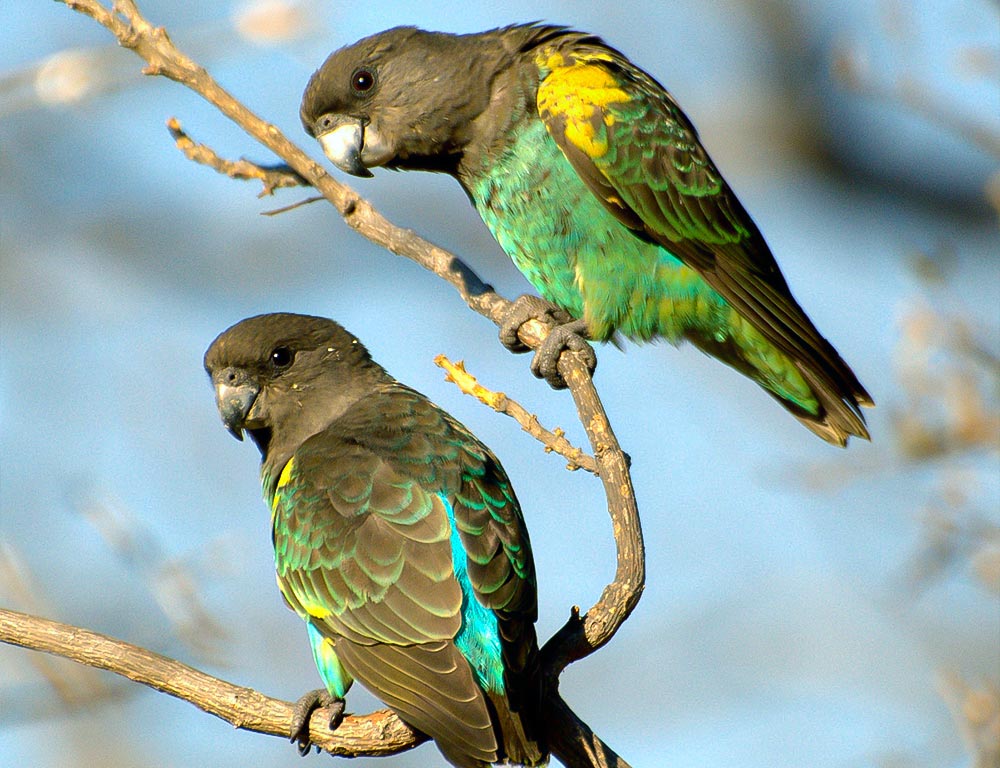
Meyer’s parrot is a species of African parrot with grey feathers, a turquoise belly, and a blue rump. It also has yellow markings on the carpal joint of its wings and some subspecies have additional yellow coloring on their heads.
Six recognized subspecies vary in terms of home range, size, and markings.
Meyer’s parrots can be found in many countries across Africa including Kenya, Ethiopia, Somalia and Tanzania where they prefer to reside amongst acacia trees near rivers or streams.
They typically feed off fruits such as figs as well as seeds from grasses and herbs which makes them incredibly important for maintaining biodiversity levels in these areas.
Scientific classification:
| Kingdom | Animalia |
| Phylum | Chordata |
| Class | Aves |
| Order | Psittaciformes |
| Family | Psittacidae |
| Genus | Poicephalus |
| Species | P. meyeri |
18. Green-Cheeked Parakeet
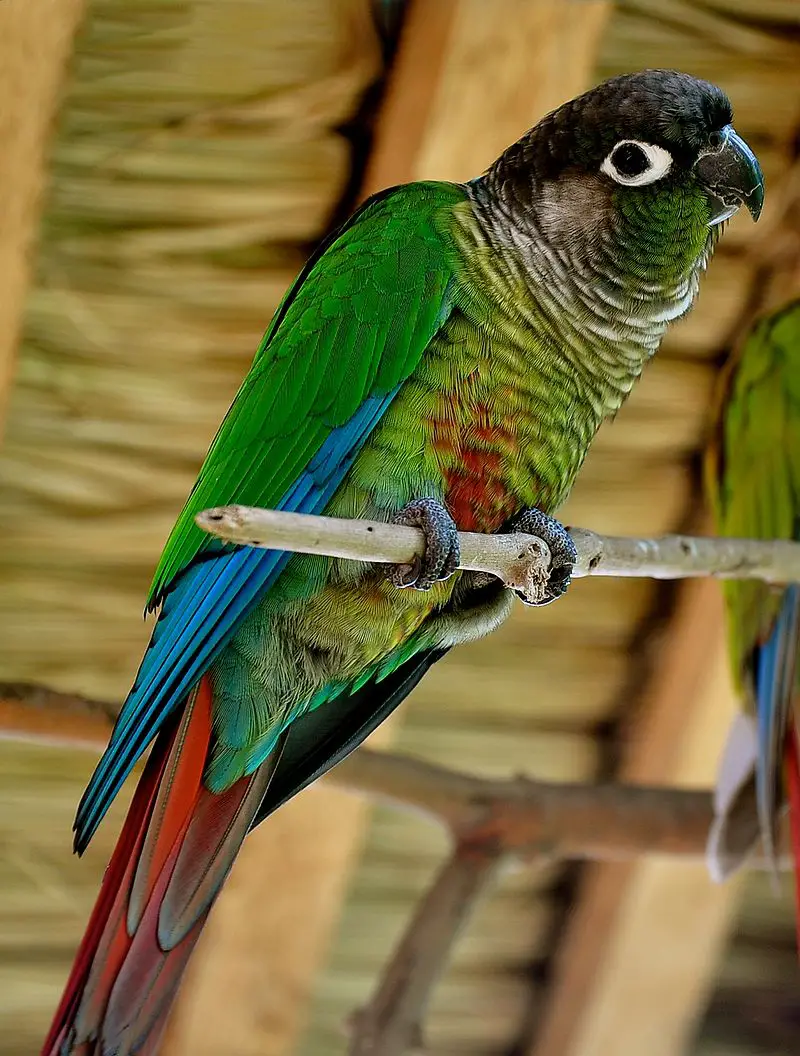
The green-cheeked parakeet is a small and colorful bird native to Central and South America. Also known as the green-cheeked conure, they are part of the long-tailed group of New World parrots from the subfamily Arinae.
These birds have been popular in aviculture for many years due to their bright plumage and playful personalities, making them excellent companion pets.
They can be noisy but also enjoy quiet time with their owners, often cuddling up into one’s neck or shoulder for naps.
Green cheeks require plenty of enrichment activities such as toys, perches, and swings to stay mentally stimulated; otherwise, they may become bored or develop unwanted behaviors.
With proper care, these vibrant birds can make amazing lifelong companions.
Scientific classification:
| Kingdom | Animalia |
| Phylum | Chordata |
| Class | Aves |
| Order | Psittaciformes |
| Family | Psittacidae |
| Genus | Pyrrhura |
| Species | P. molinae |
Also Featured In: Birds of Bolivia,
19. Grey Parrot
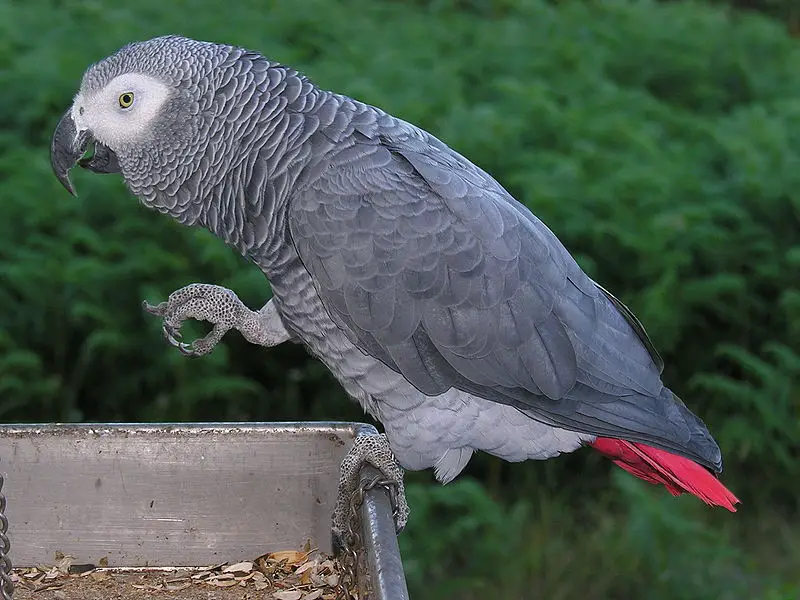
The Grey Parrot, also known as the Congo grey parrot, is a species of Old World parrot belonging to the family Psittacidae.
It was formally described by Swedish naturalist Carl Linnaeus in 1758.
This bird has an ash-grey plumage with bright red tail feathers and white markings around its eyes and beak.
They are very intelligent birds that can mimic human speech and understand basic commands.
Their diet consists mainly of fruits, nuts, seeds, vegetables, and insects found in their native African habitat or other tropical regions they inhabit such as rainforests or woodlands.
Grey parrots have become popular pets due to their intelligence and ability to learn complex behaviors like talking back when spoken too.
Scientific classification:
| Kingdom | Animalia |
| Phylum | Chordata |
| Class | Aves |
| Order | Psittaciformes |
| Family | Psittacidae |
| Genus | Psittacus |
| Species | P. erithacus |
Also Featured In: Congo Birds, Big Birds that Live in Uganda
20. Blue-Headed Parrot
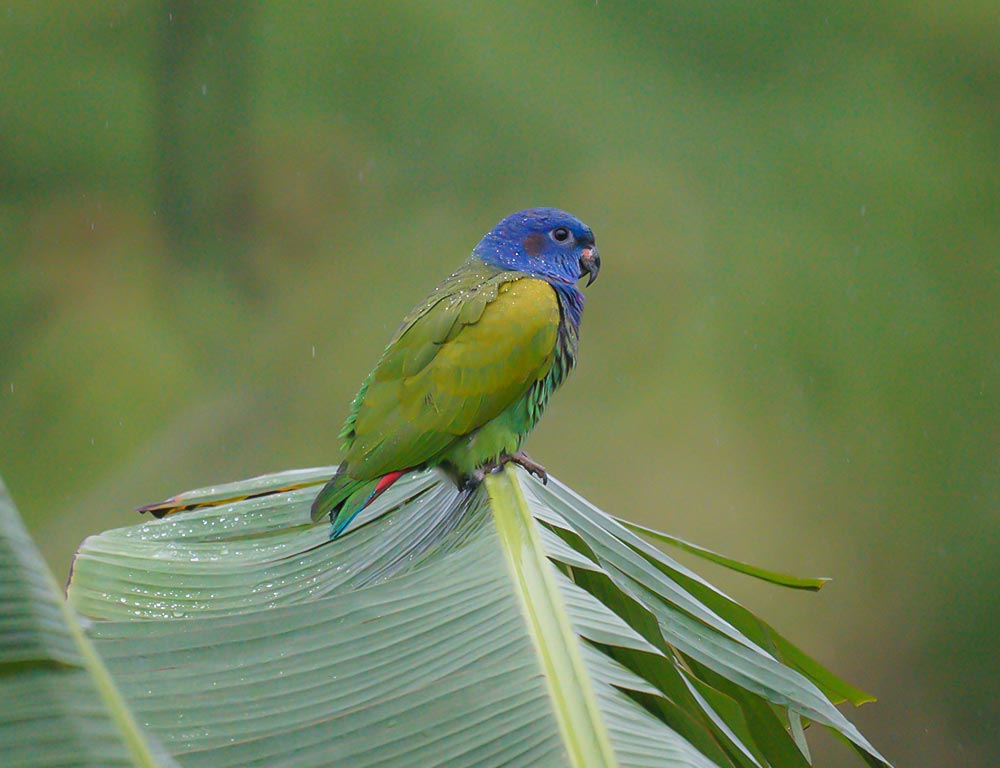
The Blue-headed Parrot is a stunning bird native to South and Central America. It measures around 27 cm in length, with its body mostly green, blue head and neck, and red undertail coverts.
This beautiful parrot lives in tropical or subtropical forests as well as savannas where it feeds on fruits such as figs, nuts, and mangos.
In the wild, they are often seen flying in small groups of up to 10 birds that chatter loudly.
They make excellent pets too due to their intelligence but require lots of attention from owners who should provide plenty of toys for them so they don’t get bored.
All in all these amazing creatures will bring joy into any home or garden.
Scientific classification:
| Kingdom | Animalia |
| Phylum | Chordata |
| Class | Aves |
| Order | Psittaciformes |
| Family | Psittacidae |
| Genus | Pionus |
| Species | P. menstruus |
Also Featured In: Panama Birds, Blue Birds You’ll Found around Us
21. Yellow-Headed Amazon
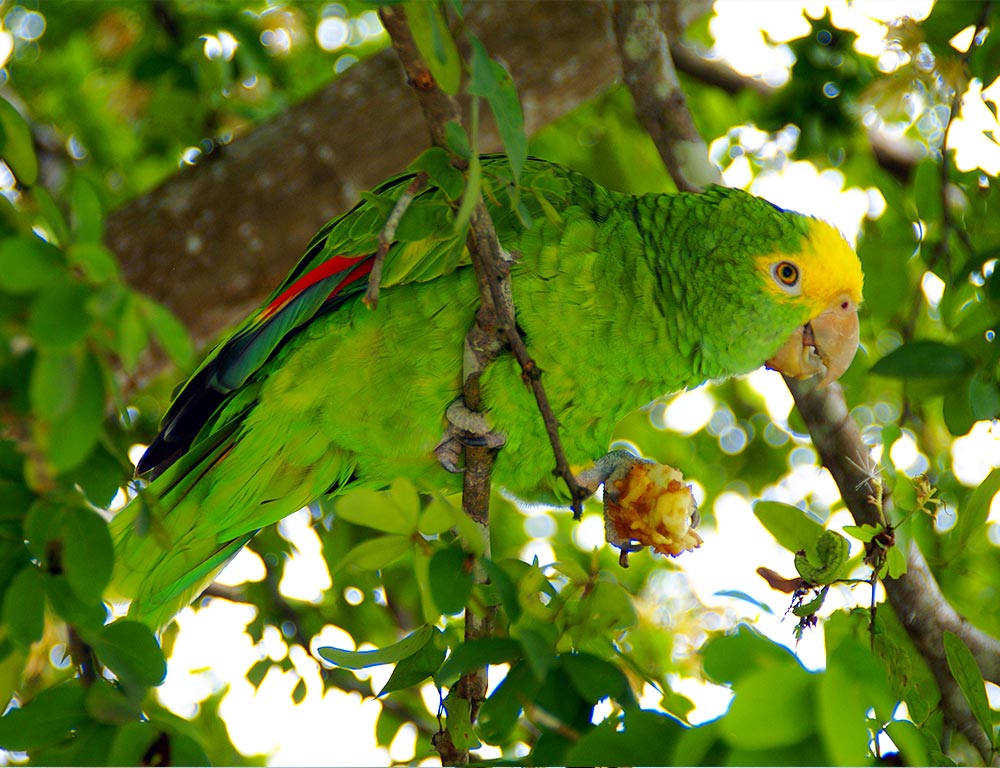
The Yellow-headed Amazon is an endangered species of parrot native to Mexico and northern Central America. It has a stocky, short-tailed body with bright green feathers and a distinct yellow head.
This bird prefers living in mangrove forests or near rivers or other bodies of water, as it requires plenty of moisture for its survival.
The Yellow-headed Amazon can measure between 15” – 17” (38 cm – 43 cm) from beak to tail, making them the largest member of their genus found in the New World.
They are social birds that live together in flocks year-round; however, they become more dispersed during breeding season when males will often form pairs with females nearby but away from the main flock.
Unfortunately due to habitat loss and deforestation, this species faces increasing threats and thus needs our help if we want them around for future generations.
Scientific classification:
| Kingdom | Animalia |
| Phylum | Chordata |
| Class | Aves |
| Order | Psittaciformes |
| Family | Psittacidae |
| Genus | Amazona |
| Species | A. oratrix |
Also Featured In: Belize Birds,
22. Ring-Necked Dove
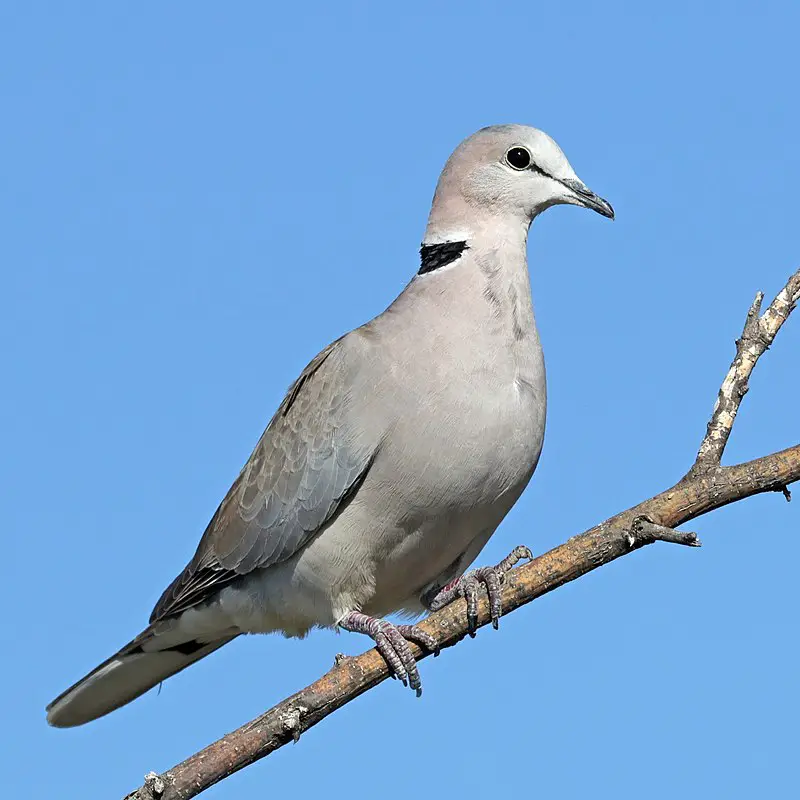
The Ring-necked Dove is a species of dove found in East and Southern Africa. It is mostly sedentary, inhabiting open habitats such as woodlands and grassland savannas.
Its distinct call – a three-syllable crooning sound can often be heard throughout the year.
The name ‘Ring-necked’ comes from its characteristic black collar with white feathers around its neck which contrasts with its brown body.
It has a single red eye ring on each side of their head that gives them an alert expression at all times.
This bird feeds mainly on seeds but also eats other small fruits or flowers when available.
They are social birds, gathering together in flocks near food sources for safety against predators like hawks or cats during nesting season.
Scientific classification:
| Kingdom | Animalia |
| Phylum | Chordata |
| Class | Aves |
| Order | Columbiformes |
| Family | Columbidae |
| Genus | Streptopelia |
| Species | S. capicola |
Also Featured In: Doves Birds,
23. Diamond Dove
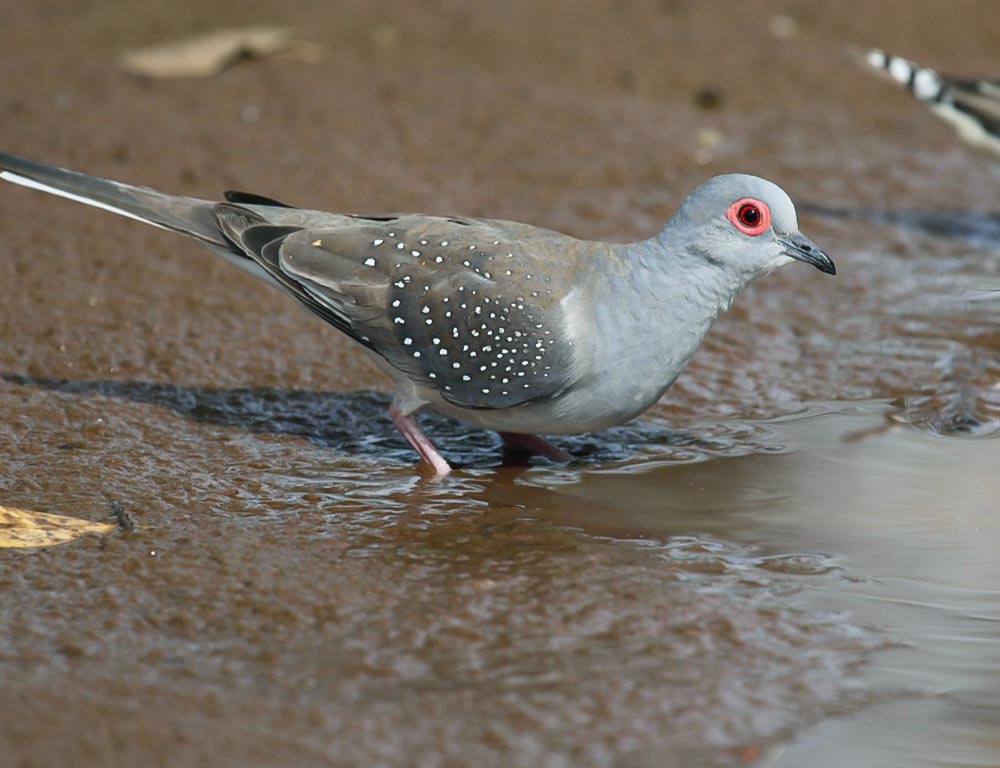
The Diamond Dove is a small pigeon species native to Australia, found mostly in central, western, and northern areas near water but which are lightly arid or semi-arid.
They have been observed occasionally in southern parks and gardens when the center of Australia experiences wetter weather conditions.
The diamond dove has an overall grey coloration with brown tints on its wings, white tips on its tail feathers, and pink legs.
Its head is adorned by two distinct black spots that form stripes down either side of the crown feathering towards the nape region.
Their diet consists mainly of seeds from grasses as well as different types of grains often found around water sources such as creeks or riversides.
These birds also enjoy bathing during rain showers though they may take some time to get used to unfamiliar environments if kept in captivity due to their shy nature.
Scientific classification:
| Kingdom | Animalia |
| Phylum | Chordata |
| Class | Aves |
| Order | Columbiformes |
| Family | Columbidae |
| Genus | Geopelia |
| Species | G. cuneata |
Also Featured In: New South Wales Birds You Need to See,
24. Zebra Finch
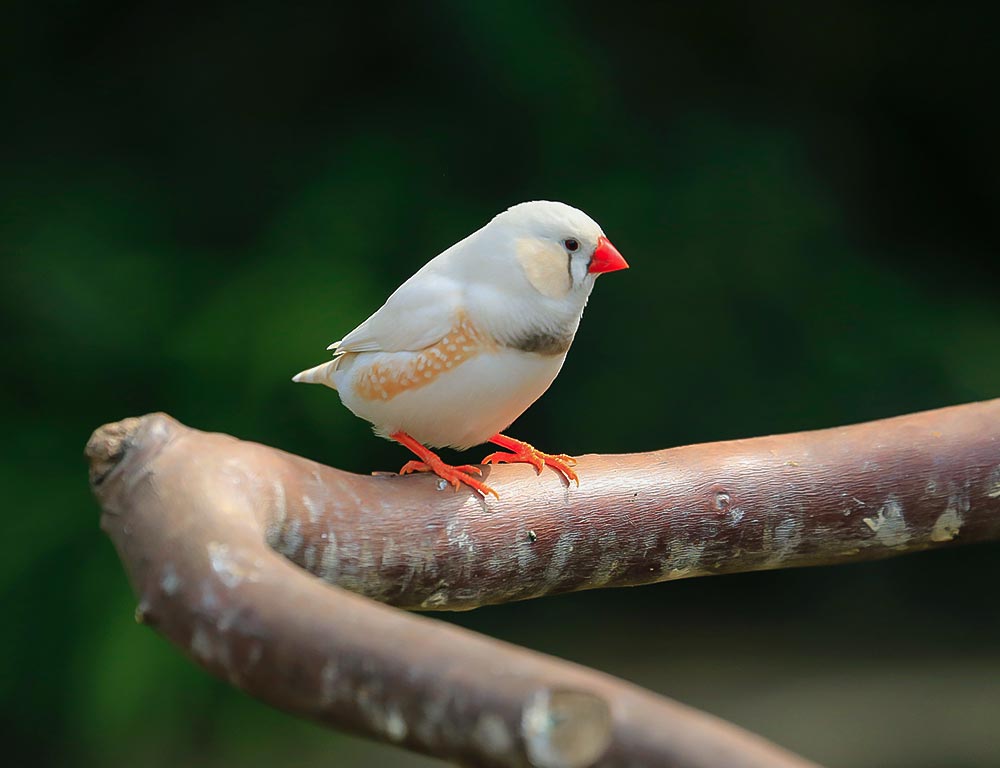
Zebra finches are two species of estrildid finch found in Australia and Indonesia. They can travel in large flocks while they feed on seeds.
The IUCN Red List and BirdLife International split them into two distinct species, the zebra finch (T. guttata) and another unnamed one, in 2016.
This recognition was later followed by the International Ornithological Congress which gave it a scientific name – Taeniopygia castanotis for this second species of zebra finches that were earlier thought to be just one single type of bird until recently.
With their bright colors including black stripes across their bodies along with the small song-like calls they make when flying around together, these beautiful little creatures offer quite a sight.
Scientific classification:
| Kingdom | Animalia |
| Phylum | Chordata |
| Class | Aves |
| Order | Passeriformes |
| Family | Estrildidae |
| Genus | Taeniopygia Reichenbach, 1862 |
Also Featured In: Finches Species, Aviary Birds You Should Know
25. Atlantic Canary
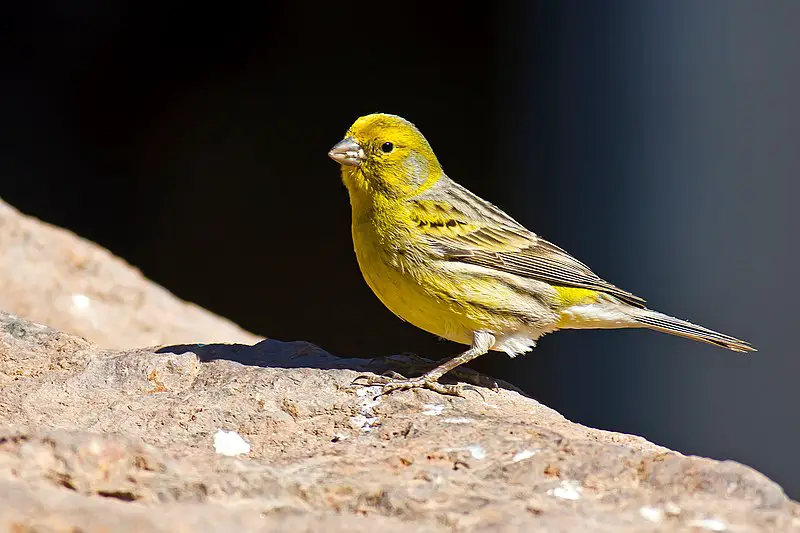
The Atlantic canary is a small, beautiful passerine bird belonging to the finch family. It is native to the Canary Islands, Madeira, and Azores islands. Wild birds are mostly yellow-green with brown streaks on their back.
They have a unique vocalization that has made them popular as cage birds all around the world.
In captivity, they are fed fruits like apples and grape seeds along with other nuts or grains for nutrition.
These small birds live in flocks among trees where they feed mainly on insects such as spiders and caterpillars which provide protein and energy necessary for survival during winter months when food sources get scarce.
Their ability to adapt quickly makes them an ideal pet choice for many people today.
Scientific classification:
| Kingdom | Animalia |
| Phylum | Chordata |
| Class | Aves |
| Order | Passeriformes |
| Family | Fringillidae |
| Subfamily | Carduelinae |
| Genus | Serinus |
| Species | S. canaria |
Also Featured In: Birds of Gran Canaria Island,
26. Sun Conure
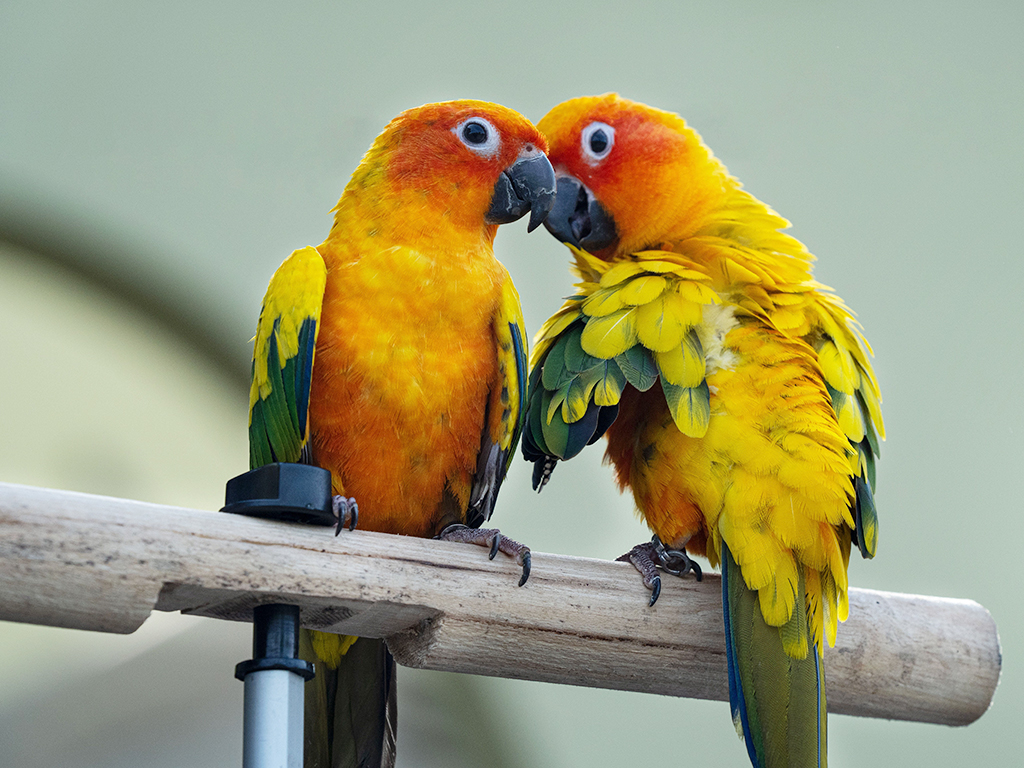
The Sun Conure is a vibrant and social species of parrot native to northeastern South America. Both males and females have predominantly golden-yellow plumage, with orange flushes under the face and wings tipped in green and blue.
They are medium-sized birds with black beaks that can make for great companions when properly cared for.
These birds love attention from their owners, so it’s important to spend quality time interacting with them regularly to ensure they remain happy and healthy.
As conures go, the Sun Conure stands out due to its bright colors which makes them popular among bird lovers around the world.
Scientific classification:
| Kingdom | Animalia |
| Phylum | Chordata |
| Class | Aves |
| Order | Psittaciformes |
| Family | Psittacidae |
| Genus | Aratinga |
| Species | A. solstitialis |
Also Featured In: Parrots Species, Rainforest Birds You Should Know
27. Red-Shouldered Macaw
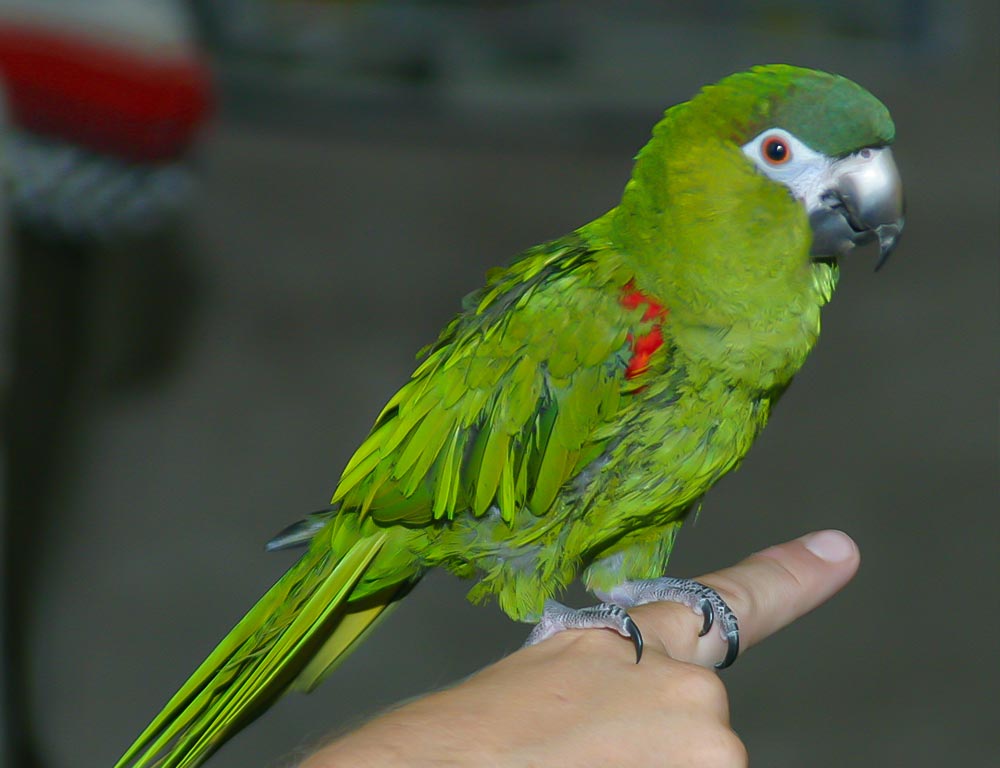
The Red-shouldered Macaw is a small South American parrot, belonging to the macaw family. Named after its bright red coverts on its wings, it measures 12 – 14 inches in length and is one of the smallest members of this group.
It can be found living in tropical lowlands, savannahs, and swamplands across Brazil and Guyana.
The species has adapted well to human presence around them so they are commonly seen near human dwelling areas such as farms or settlements where food sources are plentiful for these birds.
They have an omnivorous diet which consists mainly of fruits like palm nuts, seeds from grasses, and even insects when available.
With their beautiful green plumage and loud calls echoing through forests, they make a great addition to any backyard aviary if given enough space for flying about.
Scientific classification:
| Kingdom | Animalia |
| Phylum | Chordata |
| Class | Aves |
| Order | Psittaciformes |
| Family | Psittacidae |
| Tribe | Arini |
| Genus | Diopsittaca Ridgway, 1912 |
| Species | D. nobilis |
Also Featured In: Pet Birds that Live in India,
28. Rosy-Faced Lovebird
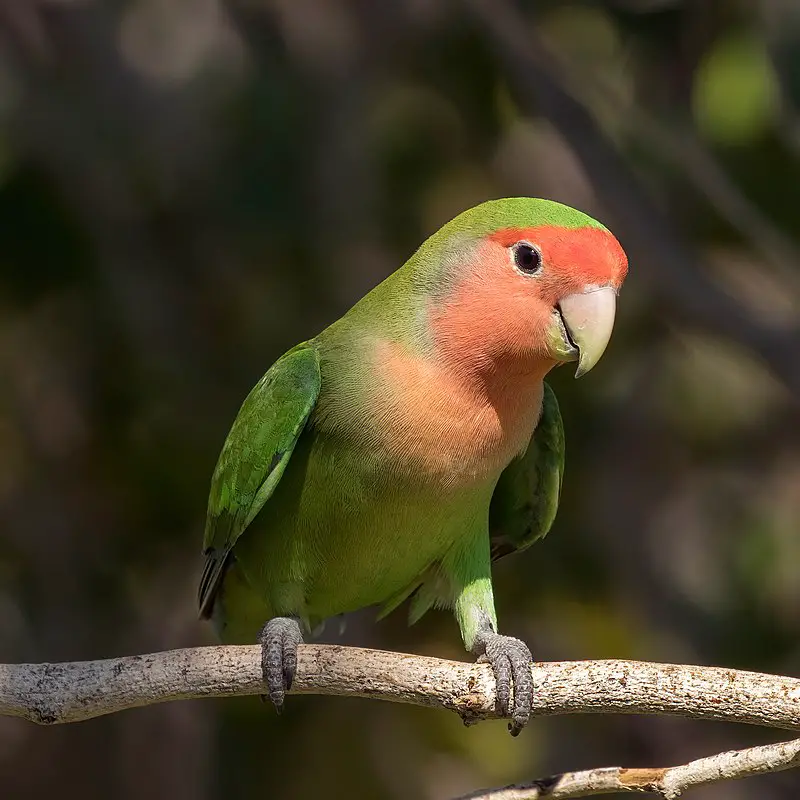
The Rosy-faced Lovebird is a vibrant and social species of bird native to arid regions in southwestern Africa. These small birds are known for their loud chirps which often come as part of large groups in the wild.
They also have wide variation between individuals when it comes to coloration, with some having more rosy hues on their faces than others.
Rosy-faced lovebirds eat throughout the day and enjoy frequent baths – they get most active during sunset when they fly around looking for food or interacting with other members of their flock.
It’s not uncommon to see these little birds playing games amongst themselves.
In captivity, they make wonderful pets due to their intelligence, friendliness, and need for companionship from humans or other animals alike; making them great fits into any home environment.
Scientific classification:
| Kingdom | Animalia |
| Phylum | Chordata |
| Class | Aves |
| Order | Psittaciformes |
| Family | Psittaculidae |
| Genus | Agapornis |
| Species | A. roseicollis |
Also Featured In: birds of green birds, Birds that Live in the Deserts
29. Amazon Parrot
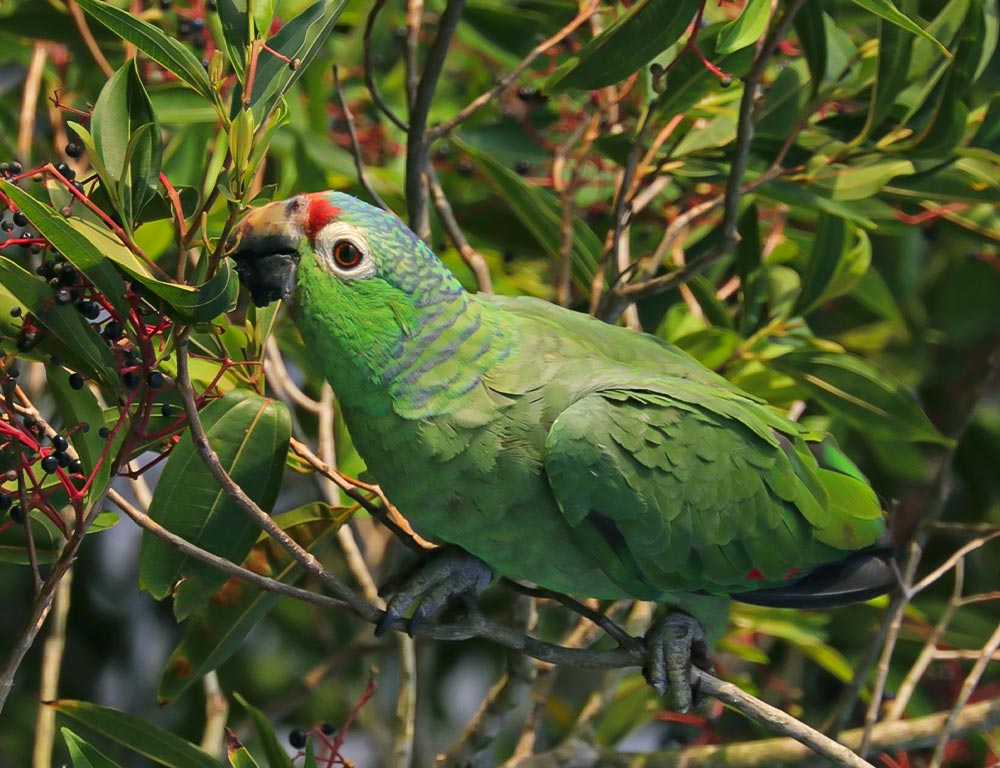
Amazon Parrots are medium-sized, short-tailed parrots native to the Americas. They belong to the genus Amazona and family Psittacidae which comprises 92 genera and three families of true parrots.
Amazon breed is known for its vibrant colors from blues, and greens to yellows that make them an eye-catching beauty in addition to their playful personalities.
These birds have a long lifespan with some living up to 80 years or more making them great companions if well taken care of.
They also possess talking abilities although this does vary between species as some will mimic human speech better than others do.
With proper training they can learn different tricks such as doing somersaults etc., providing hours of entertainment.
Scientific classification:
| Kingdom | Animalia |
| Phylum | Chordata |
| Class | Aves |
| Order | Psittaciformes |
| Family | Psittacidae |
| Tribe | Androglossini |
| Genus | Amazona Lesson, 1830 |
Also Featured In: Most Common Birds of Ko Samui,
30. Lovebirds
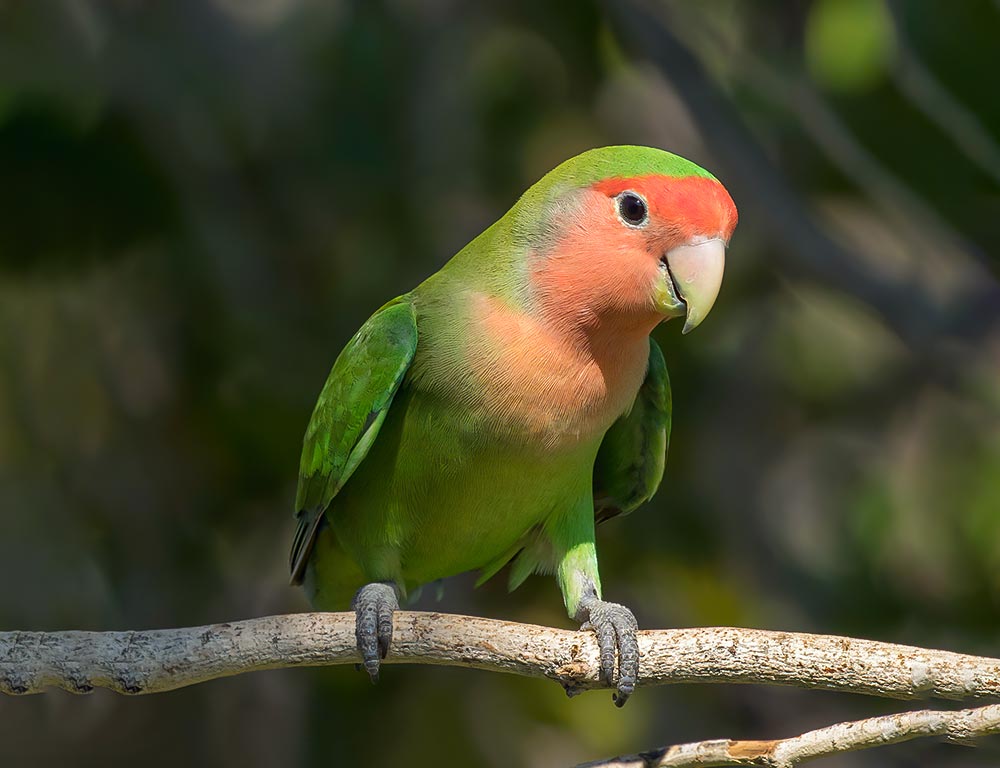
Lovebirds are small, affectionate parrots native to Africa. They form strong bonds with their partner and mate for life, hence the name.
The nine species of lovebirds range in size from 12-17 cm long, with most having bright green plumage and some sporting unique markings on their heads or faces like yellow cheek patches or grey heads.
Lovebirds are social birds that enjoy interacting with each other and human companionship as well. They can be quite vocal too – making chirps, whistles, and even screeches when they get excited.
These colorful little birds make wonderful pets if given enough space to roam around safely since they need lots of stimulation from playing with toys and activities to stay healthy mentally.
Scientific classification:
| Kingdom | Animalia |
| Phylum | Chordata |
| Class | Aves |
| Order | Psittaciformes |
| Family | Psittaculidae |
| Subfamily | Agapornithinae |
| Genus | Agapornis Selby, 1836 |
31. Pacific Parrotlet
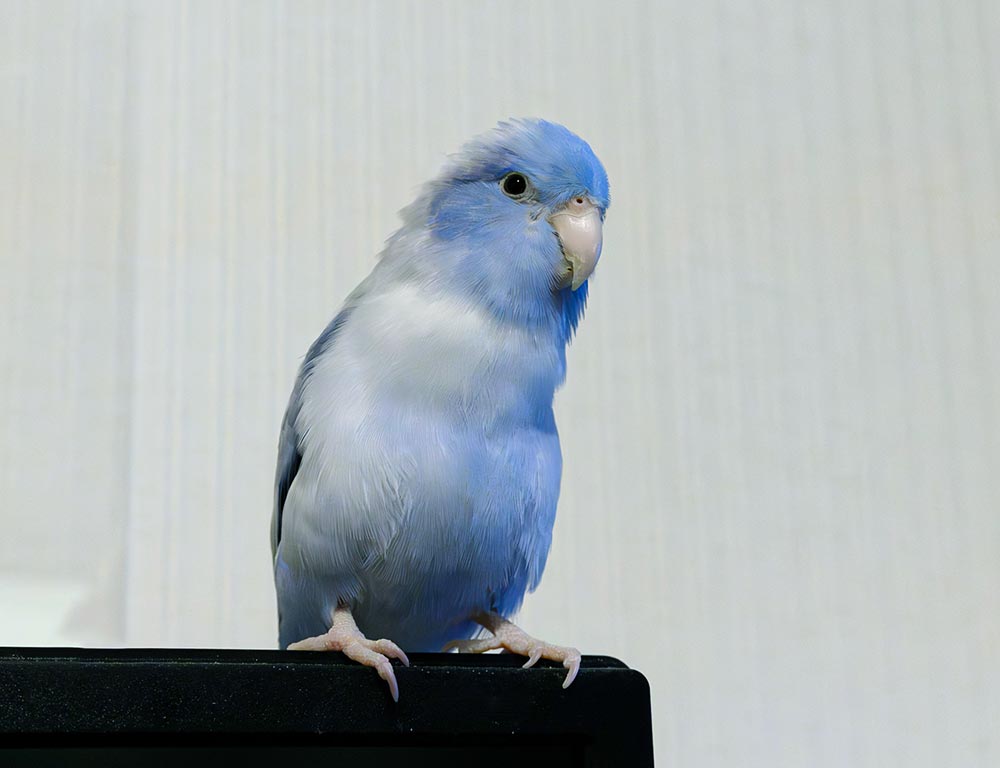
The Pacific parrotlet (Forpus coelestis), also known as Lesson’s parrotlet or the celestial parrotlet, is a species of small green bird from South America.
The average size for this beautiful creature is 11-14 cm in length and it typically weighs 30 grams – or more.
Wild specimens are usually bright green with dust-coloured wings, making them quite striking to look at.
They have short stubby tails that add to their charm and they can live up to 15 years when cared for properly.
These friendly birds make excellent pets due to their calm nature and will even learn how to say simple phrases if taught correctly.
In captivity, these Parrotlets thrive best when there is plenty of social interaction with humans and other birds alike.
Scientific classification:
| Kingdom | Animalia |
| Phylum | Chordata |
| Class | Aves |
| Order | Psittaciformes |
| Family | Psittacidae |
| Genus | Forpus |
| Species | F. coelestis |
32. Bourke’s Parrot
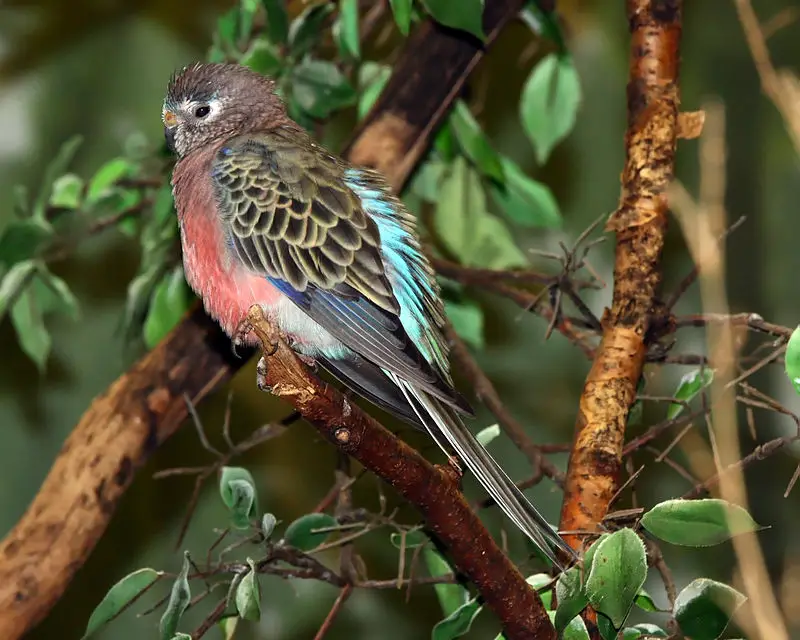
Bourke’s parrot is a small and colorful bird native to Australia. It has an olive-green body with blue feathers on the wings and tail, a pinkish chest, a white throat, and a yellow belly.
Its head is marked by two black stripes that run from its bill down its neck. This species of parrot measures 19 cm in length and weighs around 45 grams.
The Bourke’s Parakeet was named after General Sir Richard Bourke who served as Governor of New South Wales for six years beginning in 1831.
They are mainly found inhabiting dry areas such as shrublands or deserts but can also be seen in grassland habitats during the wet season when food is more abundant there.
These birds feed mostly on seeds, fruits, buds, and flowers which they pick up while flying through their environment looking for sustenance.
Scientific classification:
| Kingdom | Animalia |
| Phylum | Chordata |
| Class | Aves |
| Order | Psittaciformes |
| Family | Psittaculidae |
| Tribe | Pezoporini |
| Genus | Neopsephotus Mathews, 1912 |
| Species | N. bourkii |
Also Featured In: birds of pink,
33. Columbidae
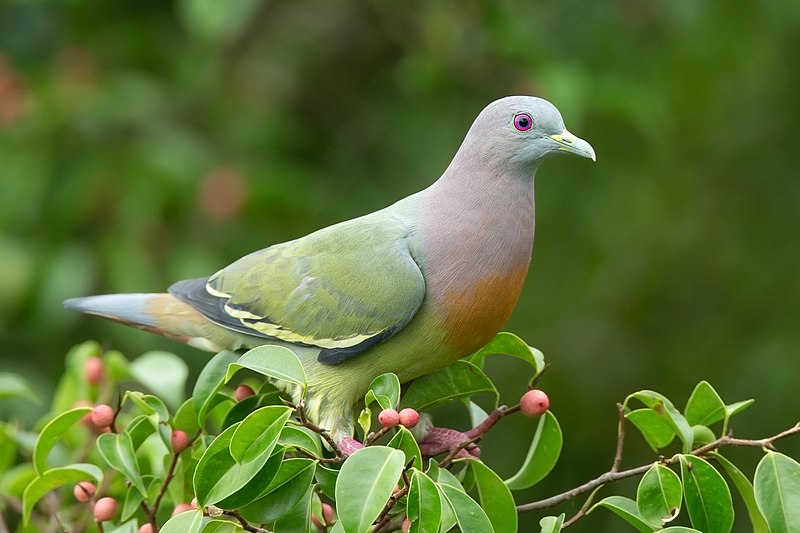
Columbidae is a bird family that includes both doves and pigeons. These birds are characterized by their stout bodies, short necks, and small slender bills with fleshy ceres in some species.
They feed mainly on seeds, fruits, and plants found all around the world but have the greatest variety in the Indomalayan and Australasian regions.
Columbidae have an unmistakable soft cooing sound which makes them one of the most beloved avian families worldwide – especially among city dwellers.
Whether it be feeding time or just hearing their soothing call throughout nature walks; these birds will remain a favorite for many more years to come.
Scientific classification:
| Kingdom | Animalia |
| Phylum | Chordata |
| Class | Aves |
| Clade | Columbimorphae |
| Order | Columbiformes Latham, 1790 |
| Family | Columbidae Leach, 1820 |
Also Featured In: birds of white, Birds for Your Home Garden
34. Common Quail
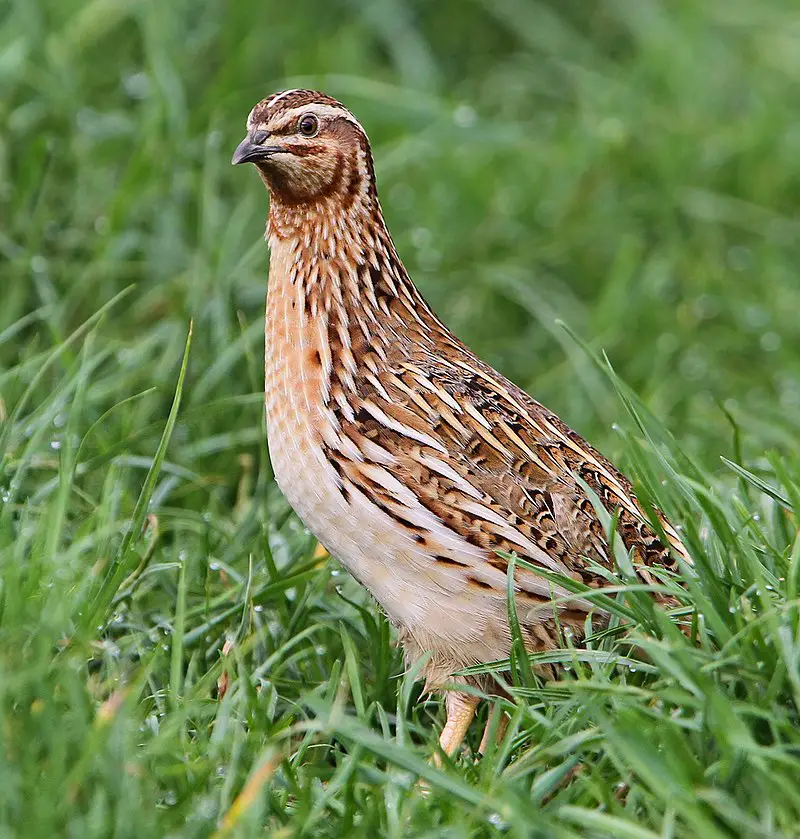
The Common quail (Coturnix coturnix) is a small ground-nesting game bird of the Phasianidae family. It breeds in the western Palearctic and winters in Africa, India, and southern parts of Europe.
Its distinctive call consists of three repeated chirps making it easier to identify than see.
They are widespread across their range, preferring grassy habitats with plenty of cover such as meadows, fields, or pastures near water sources like streams or marshes for easy access to food and protection from predators.
With their strong flying ability, they migrate long distances over vast areas during different seasons looking for suitable habitats throughout the year.
Scientific classification:
| Kingdom | Animalia |
| Phylum | Chordata |
| Class | Aves |
| Order | Galliformes |
| Family | Phasianidae |
| Genus | Coturnix |
| Species | C. coturnix |
Also Featured In: Highland Birds That You Should Know, Italian Birds You Should Know
35. Domestic Canary
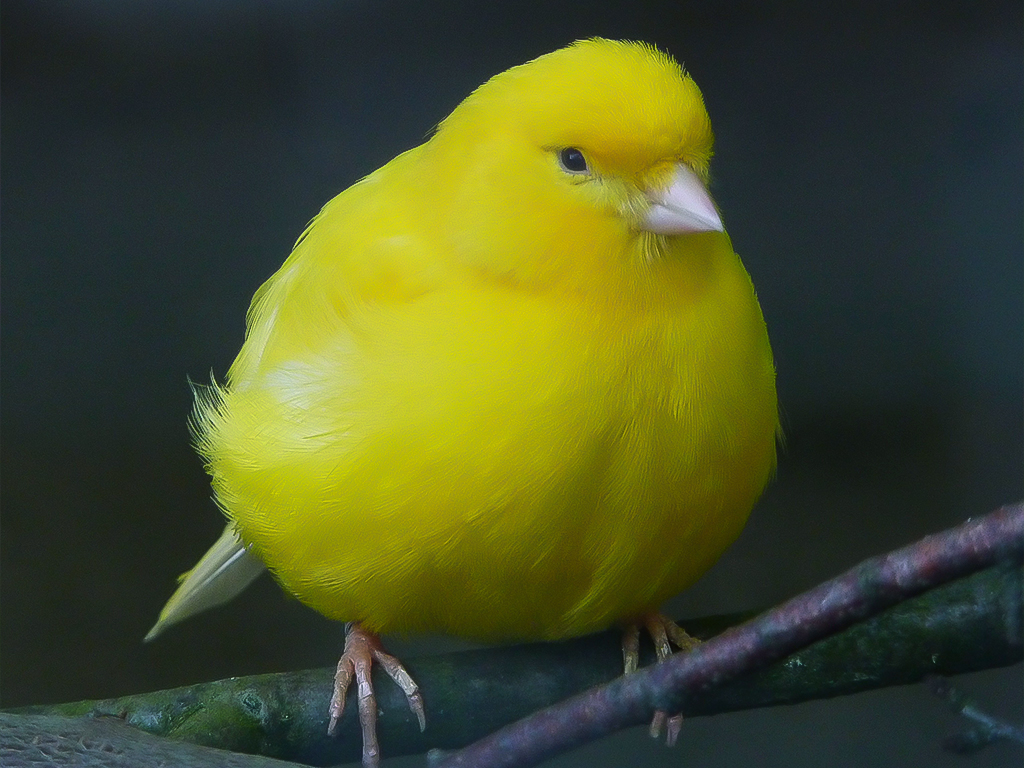
The domestic canary, also referred to as simply the canary is a small finch originating from the Macaronesian Islands. It is a domesticated form of the wild canary, often kept as a pet due to its beautiful vocal abilities.
These birds were first bred in captivity in the 17th century and were brought to Europe by Spanish sailors.
Canaries are highly valued for their melodious songs and were once considered a luxury pet due to their high cost.
Despite their small size, they have a significant impact on the pet industry and are beloved by many bird enthusiasts worldwide.
Welcome in households as well as aviaries, canaries are a popular and charming addition to any home.
Scientific classification:
| Kingdom | Animalia |
| Phylum | Chordata |
| Class | Aves |
| Order | Passeriformes |
| Family | Fringillidae |
| Subfamily | Carduelinae |
| Genus | Serinus |
| Species | S. canaria |
| Subspecies | S. c. domestica |
Also Featured In: Birds of Symbolism,
36. Australian Zebra Finch
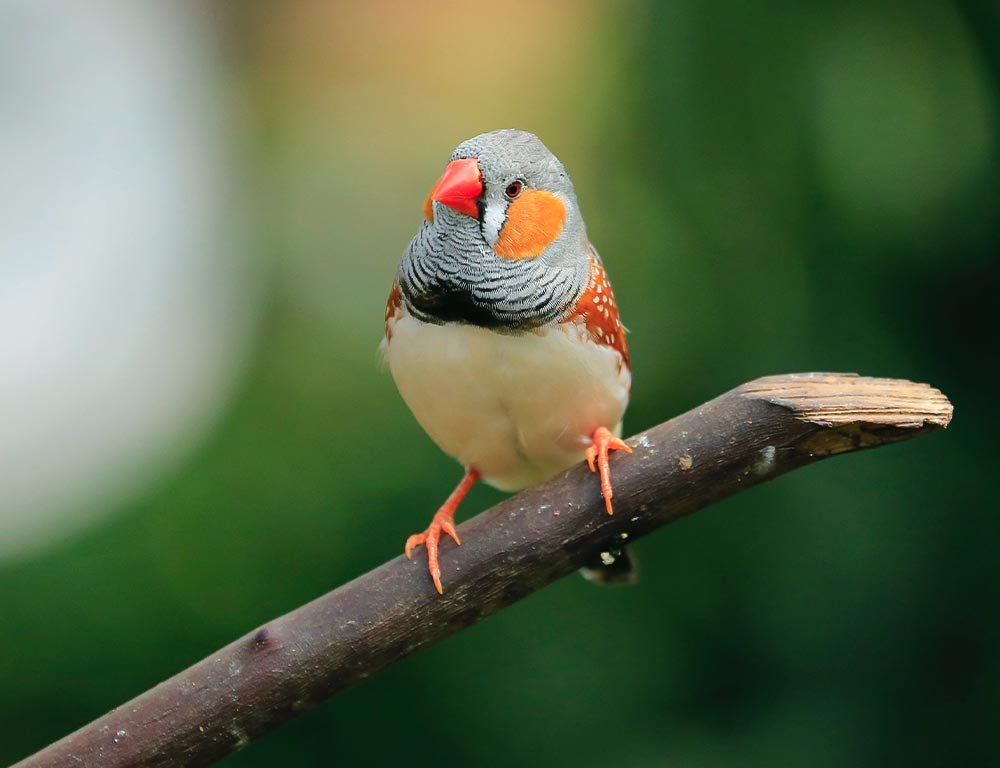
The Australian zebra finch, also known as the chestnut-eared finch, is a common bird found in Central Australia. It can be found across most of the continent, except for the cool humid southern regions and some areas of the far north.
This small bird has even been introduced to places like Puerto Rico and Portugal. Due to its ease of breeding and keeping in captivity, it has become quite popular as a pet bird.
With its distinctive black and white striped appearance, the zebra finch is a charming addition to any aviary or birdhouse.
Its chirpy, lively personality, and playful antics make it a joy to watch and listen to. It’s no wonder that this little bird is so beloved by bird enthusiasts and pet owners alike.
Scientific classification:
| Kingdom | Animalia |
| Phylum | Chordata |
| Class | Aves |
| Order | Passeriformes |
| Family | Estrildidae |
| Genus | Taeniopygia |
| Species | T. castanotis |
37. Society Finch
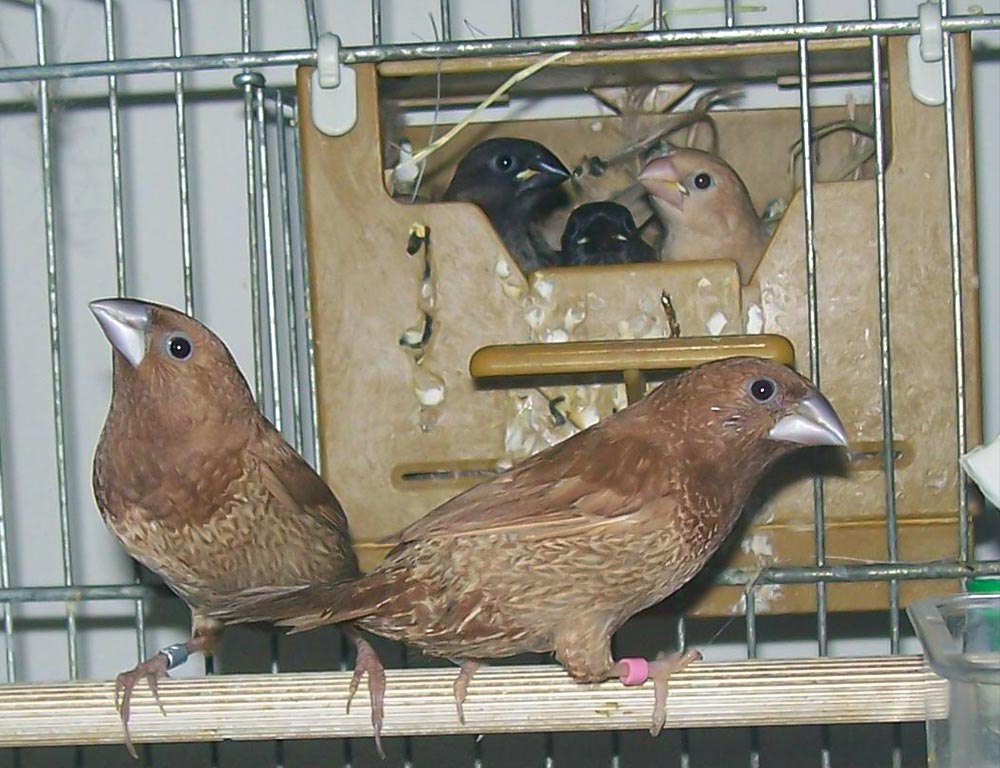
The Society finch, also known as the Bengalese finch, is a popular cage bird that was domesticated and is not found in nature. It was imported from Japan to Europe in the 1860s and became a popular trade bird.
There have been various theories about its domestication, but it is now known that it occurred in Japan before it was brought to Europe.
The bird is generally small in size and has a greyish-brown plumage. Its docile nature makes it an ideal pet bird for those who want a low-maintenance companion.
Overall, the Society finch has become a beloved pet bird for bird enthusiasts worldwide.
Scientific classification:
| Kingdom | Animalia |
| Phylum | Chordata |
| Class | Aves |
| Order | Passeriformes |
| Family | Estrildidae |
| Genus | Lonchura |
| Species | L. striata |
| Subspecies | L. s. domestica |
38. Caique
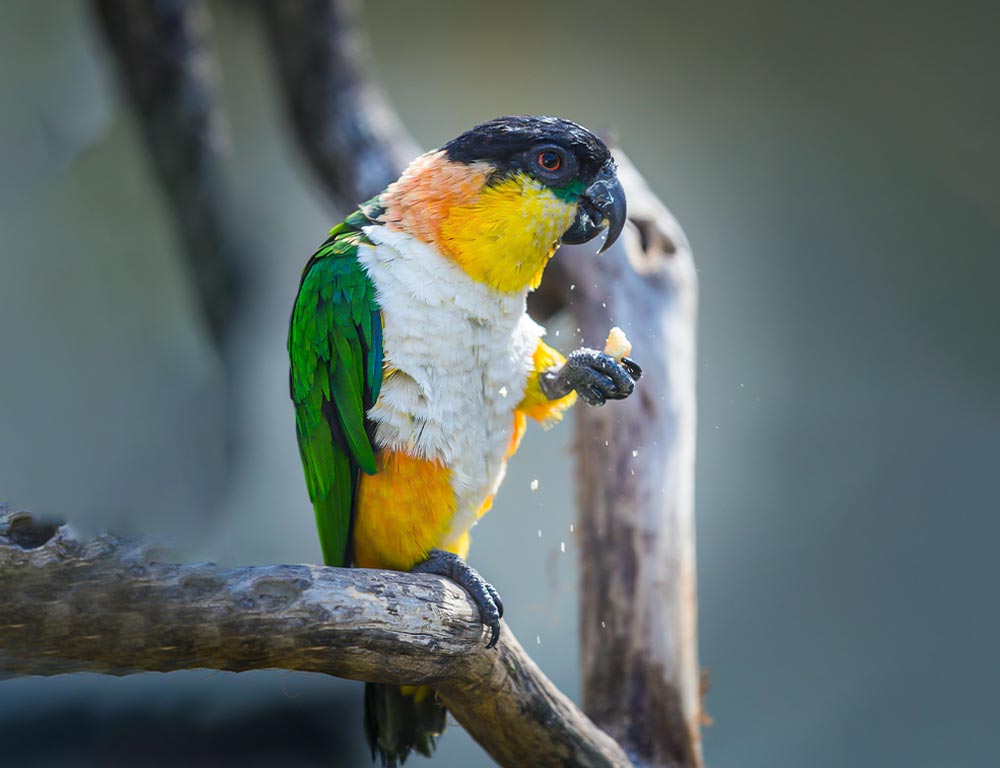
The Caique is a bird species found exclusively in the Amazon Basin of South America. It is a group of four parrots belonging to the genus Pionites.
These birds are mainly known and referred to as “black-headed parrots” and “white-bellied parrots.” The term “Caique” is usually used in aviculture, whereas ornithologists commonly use other names.
The Caique bird is an adorable, active, and sociable pet bird. It is a medium-sized parrot with a cheerful temperament and loves to play.
The bird’s plumage is bright and colorful, featuring a green body, yellow-orange undersides, and a black head.
Caiques are intelligent birds that can learn several words and phrases. They are also known for their acrobatic abilities and love to perform tricks.
Caiques are highly recommended as pet birds for their outgoing personalities and playful nature.
Scientific classification:
| Kingdom | Animalia |
| Phylum | Chordata |
| Class | Aves |
| Order | Psittaciformes |
| Family | Psittacidae |
| Subfamily | Arinae |
| Genus | Pionites Heine, 1890 |
39. Chicken

The chicken, a commonly domesticated species, originates from Southeast Asia and exhibits traits of wild grey and Ceylon junglefowl. Adult male birds are referred to as roosters or cocks, while a younger male is called a cockerel.
A castrated male is called a capon. Adult female chickens are known as hens and sexually immature females are known as pullets.
Chickens are known for their ability to lay eggs and are often raised for meat consumption. They come in a variety of breeds and can have different colors and patterns on their feathers.
Chickens are also popular as pets and often require a coop or enclosure for proper care.
Scientific classification:
| Kingdom | Animalia |
| Phylum | Chordata |
| Class | Aves |
| Order | Galliformes |
| Family | Phasianidae |
| Genus | Gallus |
| Species | G. gallus |
| Subspecies | G. g. domesticus |
Also Featured In: Asian Birds, Birds that are Used in Feng Shui
40. Moluccan Eclectus
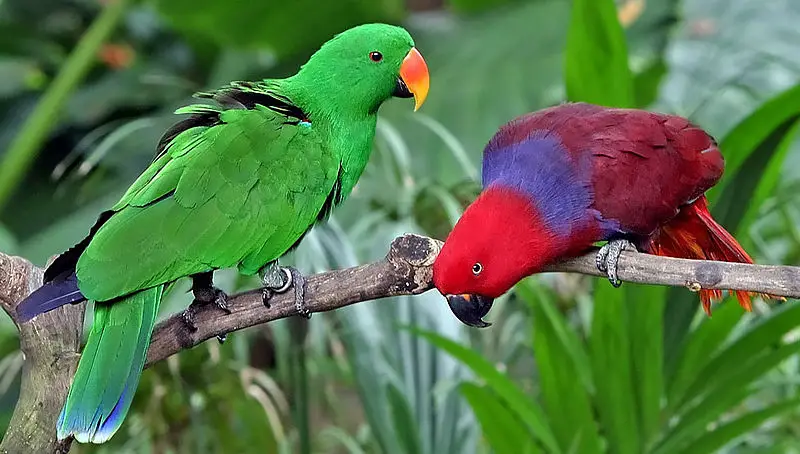
The Moluccan eclectus is a parrot that can be found on the Maluku Islands. This bird is well-known for its striking sexual dimorphism, with males sporting bright emerald plumage, while females have mostly red and purple/blue feathers.
What sets this bird apart from other parrots is the extreme color difference between genders. As described in Joseph Forshaw’s book Parrots of the World, it’s one of the few species that displays such a distinct difference in coloration.
The Moluccan eclectus is truly a unique bird with an unusual and fascinating trait.
Scientific classification:
| Kingdom | Animalia |
| Phylum | Chordata |
| Class | Aves |
| Order | Psittaciformes |
| Family | Psittaculidae |
| Genus | Eclectus |
| Species | E. roratus |
41. Loriini
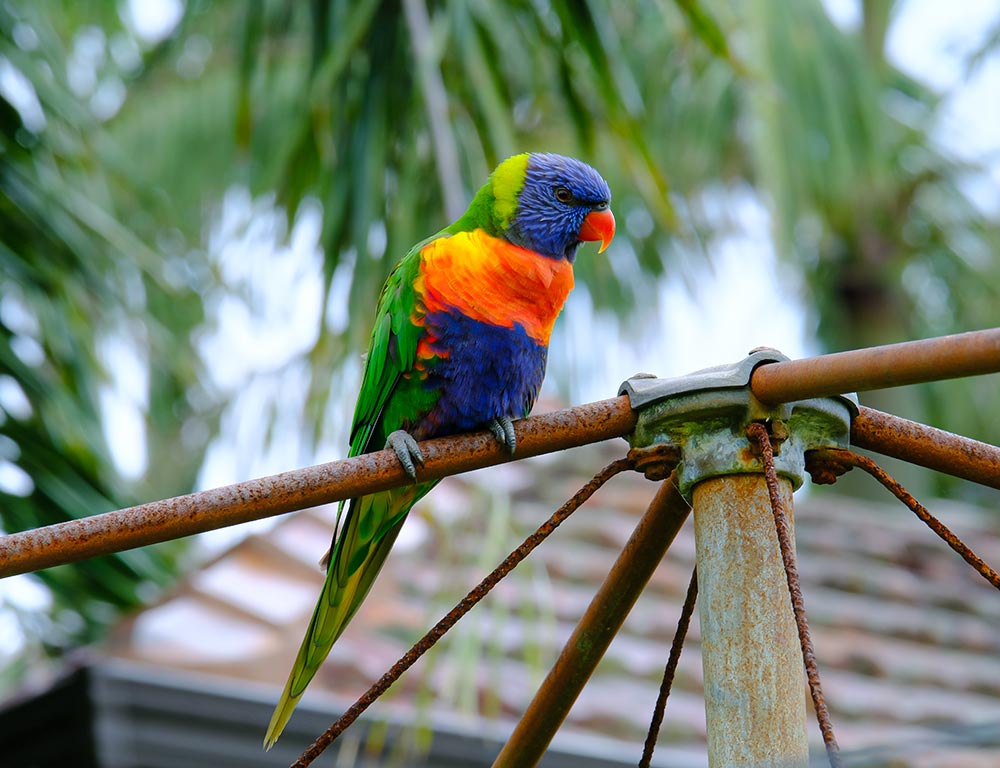
Loriini birds are a tribe of parrots known for their specialized tongues that are brush-tipped for feeding on nectar and soft fruits, such as berries. They are small to medium in size and live in trees.
The Loriini form a monophyletic group within the Psittaculidae family of parrots and includes subgroups such as lories and lorikeets.
While traditionally they were considered a separate subfamily called Loriinae, this is no longer the case.
These birds are known for their bright colors and playful personalities. They are primarily found in the forests of the Pacific and Indian Oceans, with some species also found in Australia.
These birds are important pollinators for many plant species and their diets are important for maintaining the health of many ecosystems.
Overall, Loriini birds are fascinating creatures that play vital roles in their ecosystems.
Scientific classification:
| Kingdom | Animalia |
| Phylum | Chordata |
| Class | Aves |
| Order | Psittaciformes |
| Family | Psittaculidae |
| Subfamily | Loriinae |
| Tribe | Loriini Selby, 1836 |
Also Featured In: Sydney Birds You Need to See,
42. True Parrot
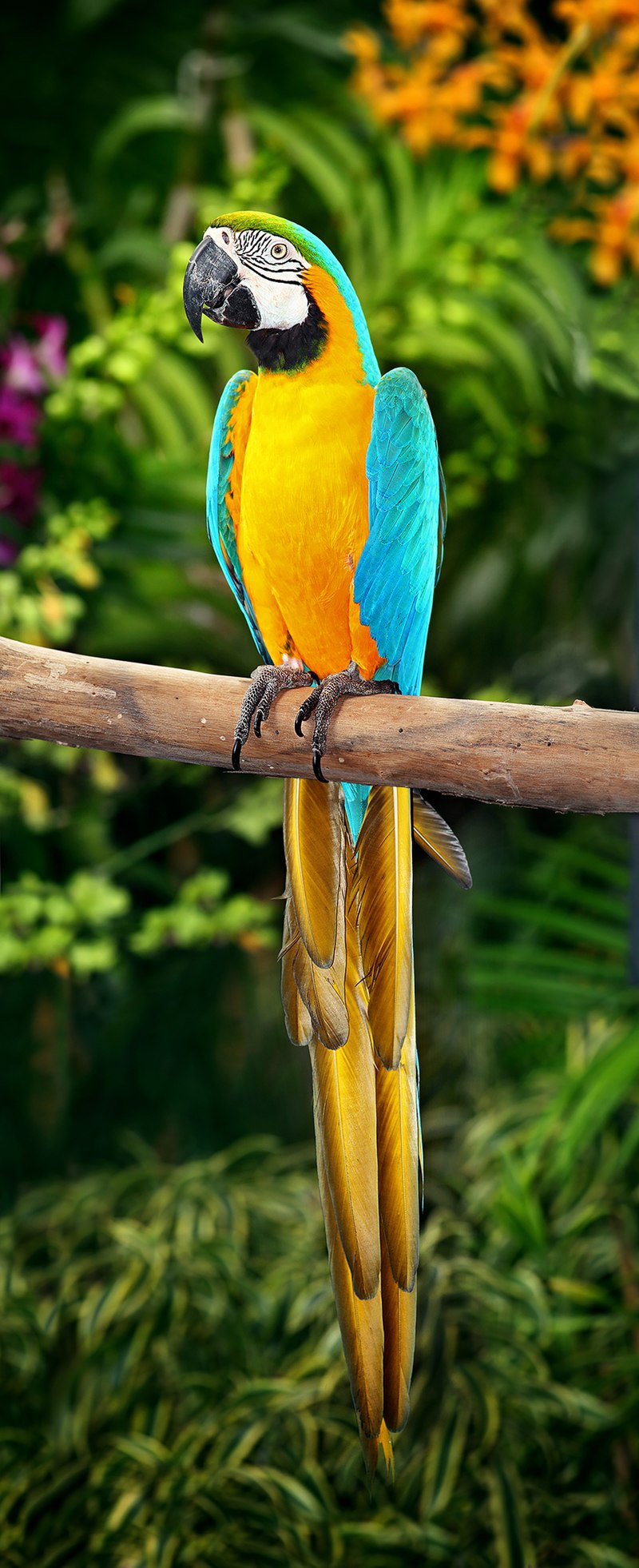
True parrots are a diverse group of over 350 species of hook-billed birds found all over the world. They belong to two of the three superfamilies in the order Psittaciformes.
Most true parrots are herbivorous and feed mainly on plant material. They are known for their bright plumage, intelligence, and ability to mimic human speech.
These birds are widespread and found in many countries including Mexico, Central and South America, sub-Saharan Africa, India, Southeast Asia, Australia and the Pacific region.
They play an important role in many ecosystems as pollinators and seed dispersers. In some areas, they are also popular pets, although the pet trade can have negative impacts on wild populations.
Overall, true parrots are an important and fascinating group of birds.
Scientific classification:
| Kingdom | Animalia |
| Phylum | Chordata |
| Class | Aves |
| Order | Psittaciformes |
| Superfamily | Psittacoidea Illiger, 1811 |
43. Pionus
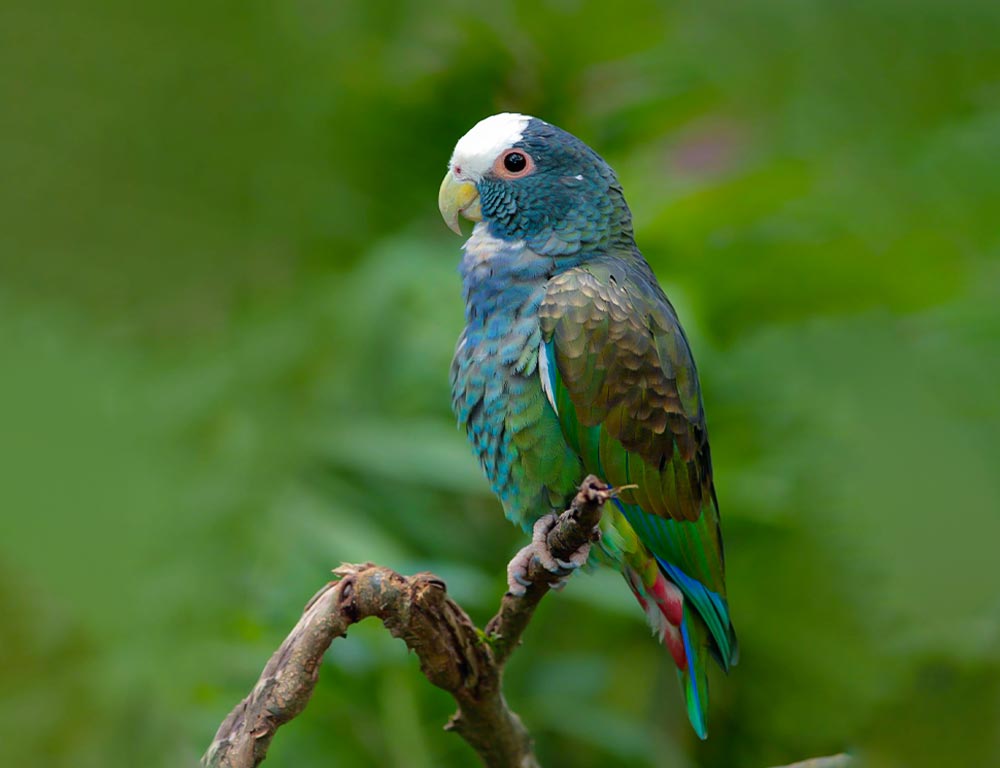
Pionus birds are medium-sized parrots found in Mexico, and Central and South America. They have a chunky body, a bare eye ring that can come in different colors, and a short square tail.
Although they are similar to Amazon parrots, they are smaller and have deeper wing-strokes when in flight. Their coloration is complex and subdued, distinguishing them from other species.
They are a genus of parrots that are not flashy or showy but have a unique beauty. Pionus birds are popular as pets due to their quieter nature and gentle personalities. They are intelligent and social creatures that bond closely with their owners.
Overall, Pionus birds are a fascinating and beautiful addition to the world of parrots.
Scientific classification:
| Kingdom | Animalia |
| Phylum | Chordata |
| Class | Aves |
| Order | Psittaciformes |
| Family | Psittacidae |
| Tribe | Androglossini |
| Genus | Pionus Wagler, 1832 |
44. Parrots
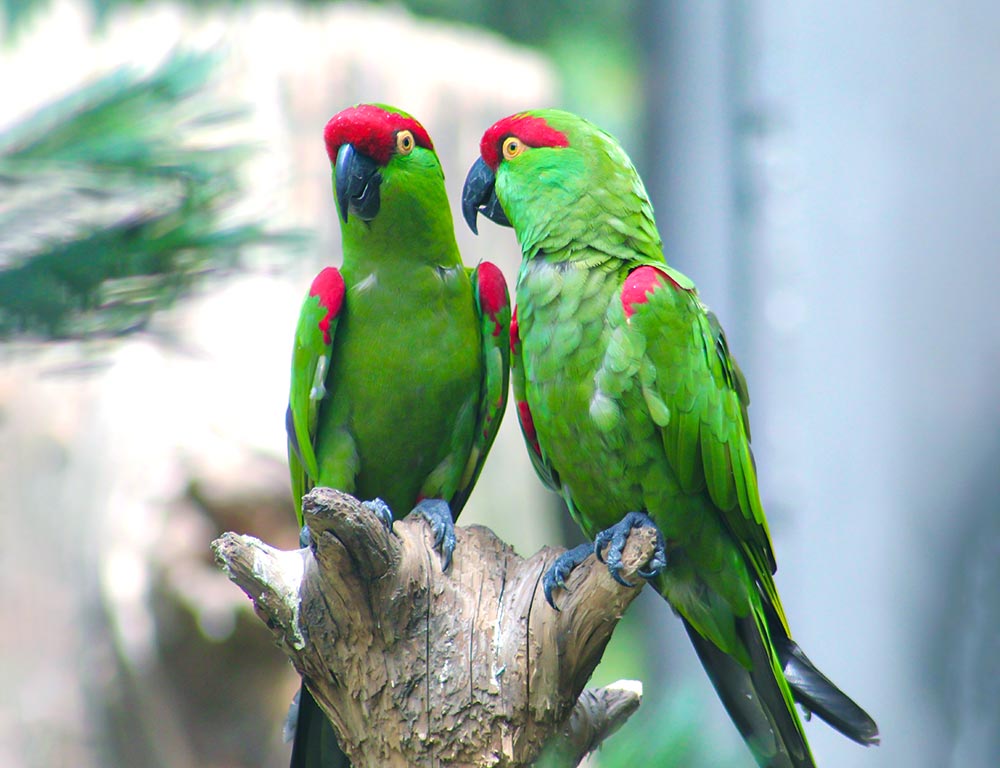
Parrots are a diverse and fascinating group of birds. They belong to the family Psittacidae, which includes both Old World and New World species.
These colorful birds are known for their ability to mimic human speech and their playful, sociable personalities.
Parrots have strong, curved beaks that are adapted for cracking nuts and seeds. They also have zygodactyl feet, which means their toes are arranged in pairs, two facing forward and two facing backward, allowing them to grasp branches and perch securely.
Parrots are found across the globe, from the rainforests of South America to the deserts of Australia.
Unfortunately, many species of parrots are threatened by habitat loss and illegal pet trade. Conservation efforts are underway to protect these beloved birds and their habitats.Scientific classification:
| Kingdom | Animalia |
| Phylum | Chordata |
| Class | Aves |
| Order | Psittaciformes |
| Superfamily | Psittacoidea |
| Family | Psittacidae Rafinesque, 1815 |
45. White Cockatoo
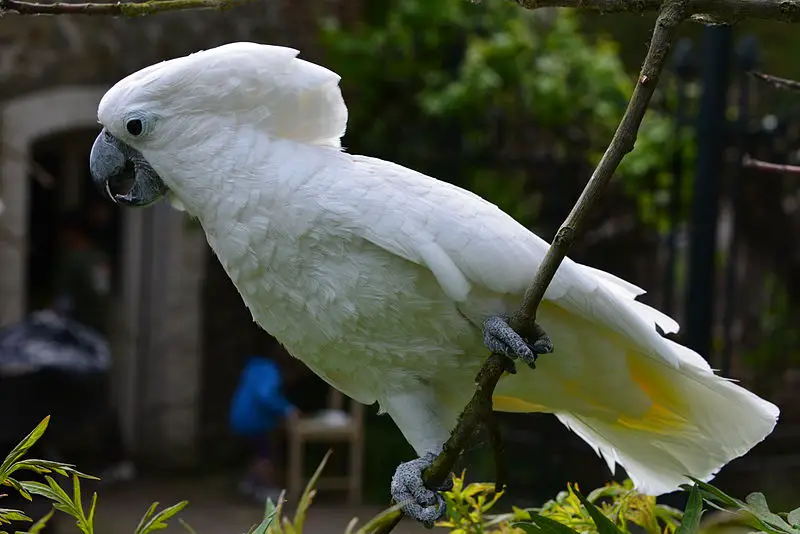
The White Cockatoo, also called the Umbrella Cockatoo, is a medium-sized bird found in Indonesia’s tropical rainforests. This majestic bird is entirely white, with a semicircular head crest that it extends when startled.
Its wings and tail exhibit a light yellow or lemon hue when in flight. These birds are incredibly intelligent and thrive on social interaction, making them popular pets.
However, they require careful attention and an ample enclosure that allows for sufficient exercise.
These birds have a lifespan of over 40 years and make loyal companions. They are also known for their exceptional ability to mimic sounds and words.
The White Cockatoo is a magnificent bird that requires love, care, and attention from its owners to thrive.
Scientific classification:
| Kingdom | Animalia |
| Phylum | Chordata |
| Class | Aves |
| Order | Psittaciformes |
| Family | Cacatuidae |
| Genus | Cacatua |
| Subgenus | Cacatua |
| Species | C. alba |
46. Yellow Canary
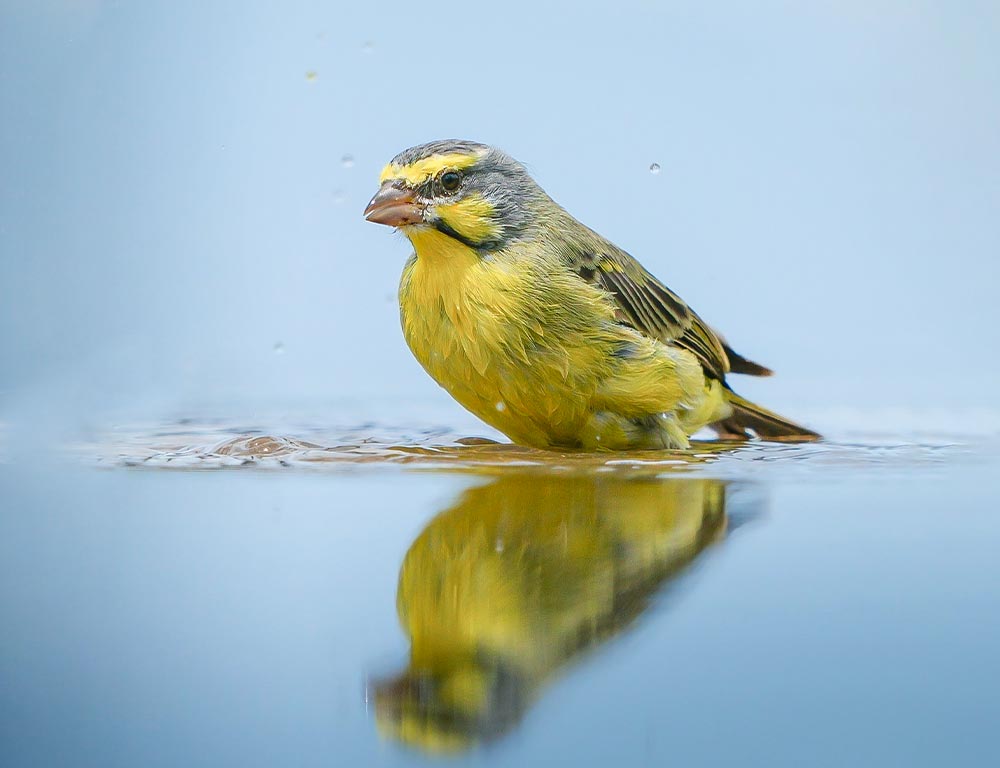
The Yellow Canary is a small finch bird found in southern Africa. It is a resident breeder in the western and central regions of the area. The bird has a yellow plumage and is known for its sweet and melodious song.
The Yellow Canary is often kept as a pet and has been introduced to Ascension and St Helena islands. It was originally classified in the genus Serinus, but recent studies have found that the genus was polyphyletic.
The Yellow Canary is a popular aviary bird and is prized for its beautiful appearance and charming singing voice.
Because it is often kept in captivity, the species is not considered to be endangered.
Scientific classification:
| Kingdom | Animalia |
| Phylum | Chordata |
| Class | Aves |
| Order | Passeriformes |
| Family | Fringillidae |
| Subfamily | Carduelinae |
| Genus | Crithagra |
| Species | C. flaviventris |
47. Red Factor Canary
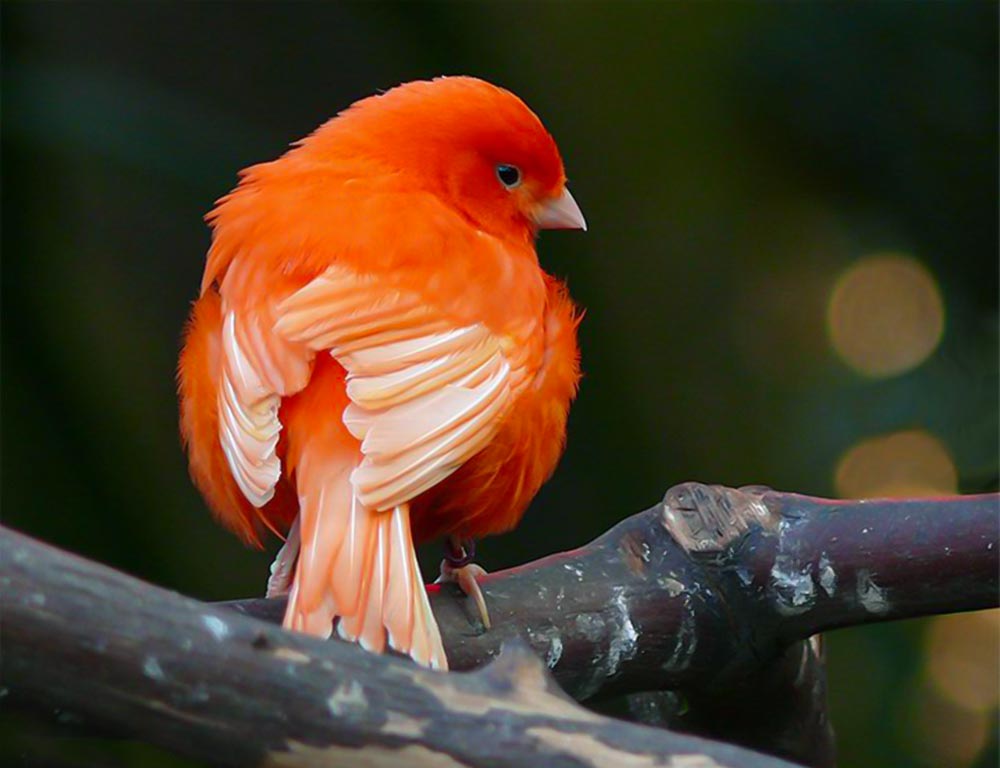
The Red Factor Canary bird is a distinctive breed that has striking red or orange feathers. This coloration is the result of careful breeding and genetics, rather than diet or environment.
These canaries are popular as pets due to their unique appearance and cheerful singing. They are also competitive birds, and many owners enjoy showing them in avian exhibitions.
As with all birds, proper care and nutrition are key to keeping Red Factor Canaries healthy and happy.
They thrive on a diet of high-quality seed mixes, fresh fruit and vegetables, and clean water. Adequate space and social interaction are also important for their well-being.
With proper care, a Red Factor Canary can live up to 10 years and bring joy and beauty to their owners throughout their lives.
48. Tanimbar Corella
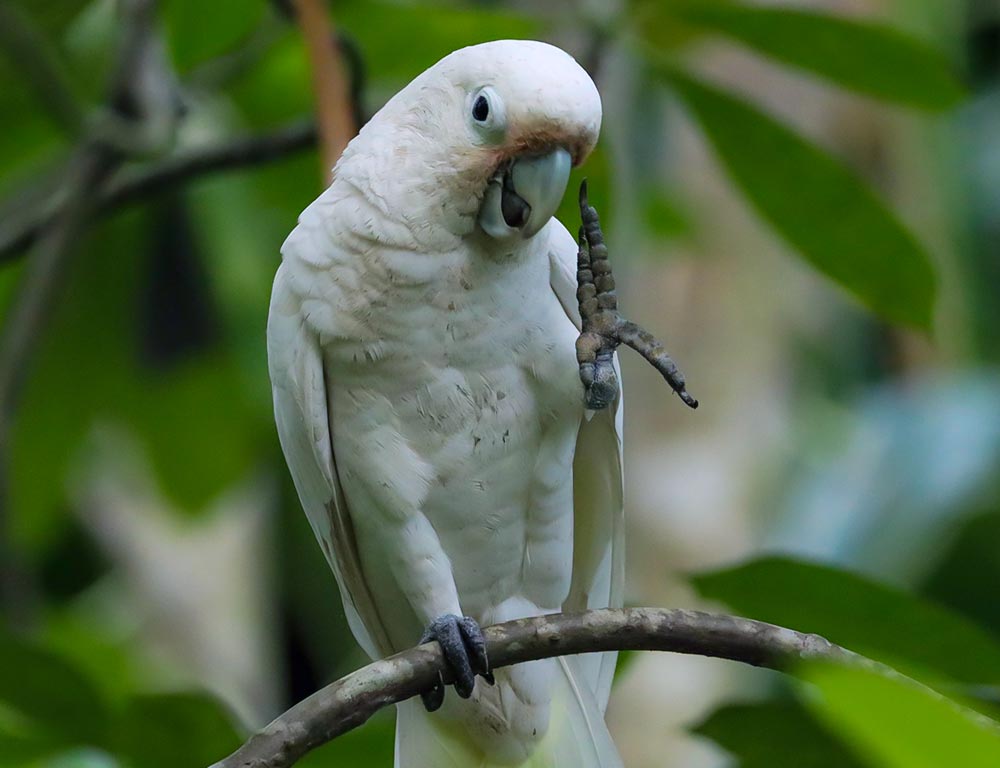
The Tanimbar corella, also known as Goffin’s cockatoo, is a type of cockatoo bird found in the Tanimbar Islands of Indonesia. they can be found in the forests of Yamdena, Larat, and Selaru islands.
This particular species has also been introduced to a few other islands such as the Kai Islands, Singapore, and Puerto Rico. Interestingly, it was only described in 2004 after being discovered by scientists.
Known for its distinct white and pink feathers, the Tanimbar corella is a sought-after bird in the pet trade.
However, due to its limited natural range and genetic distinctness, conservation efforts are underway to protect this beautiful bird species.
Scientific classification:
| Kingdom | Animalia |
| Phylum | Chordata |
| Class | Aves |
| Order | Psittaciformes |
| Family | Cacatuidae |
| Genus | Cacatua |
| Subgenus | Licmetis |
| Species | C. goffiniana |
Also Featured In: Big Birds that Live in Singapore,
49. Chattering Lory
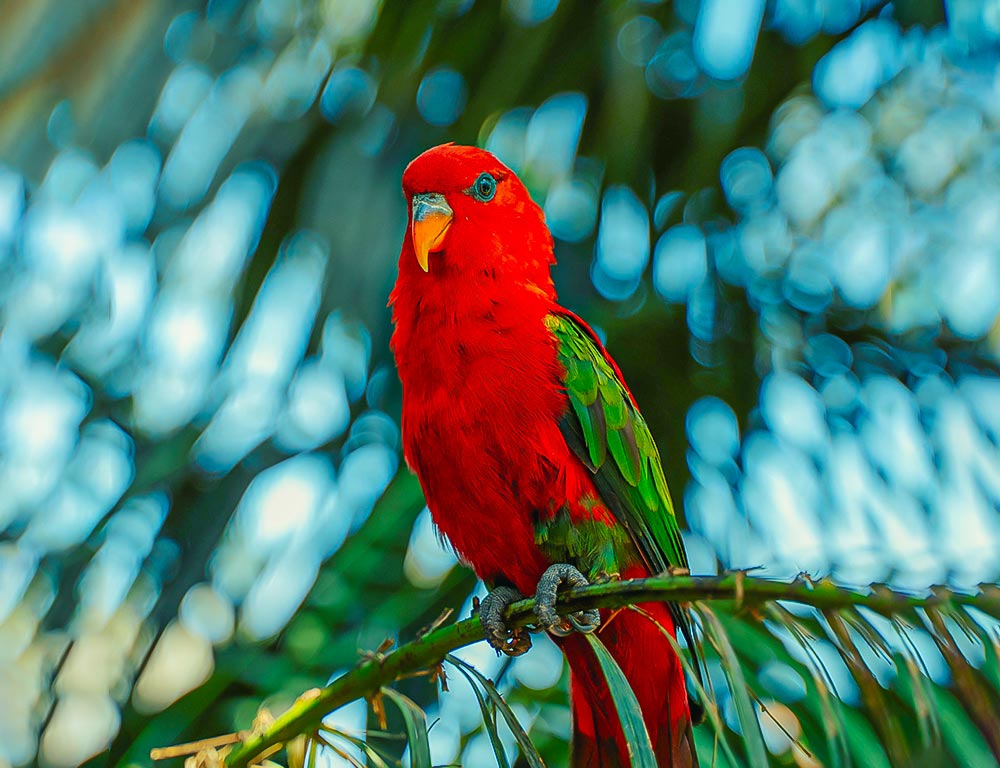
The chattering lory is a vibrant parrot found only in the North Maluku region of Indonesia. This forest-dwelling bird is at risk due to trapping for the cage-bird trade, making it a vulnerable species.
The yellow-backed lory, also known as L. g. flavopalliatus, is a subspecies of the chattering lory. Carl Linnaeus, a Swedish naturalist, first described this bird in 1758 in the tenth edition of his Systema Naturae.
With its colorful plumage and chatty nature, the chattering lory is a beloved species among bird enthusiasts. However, efforts must be made to protect this vulnerable bird from the threats it faces.
Scientific classification:
| Kingdom | Animalia |
| Phylum | Chordata |
| Class | Aves |
| Order | Psittaciformes |
| Family | Psittaculidae |
| Genus | Lorius |
| Species | L. garrulus |
Also Featured In: Birds that Live Near Halmahera,
50. Black-Headed Parrot
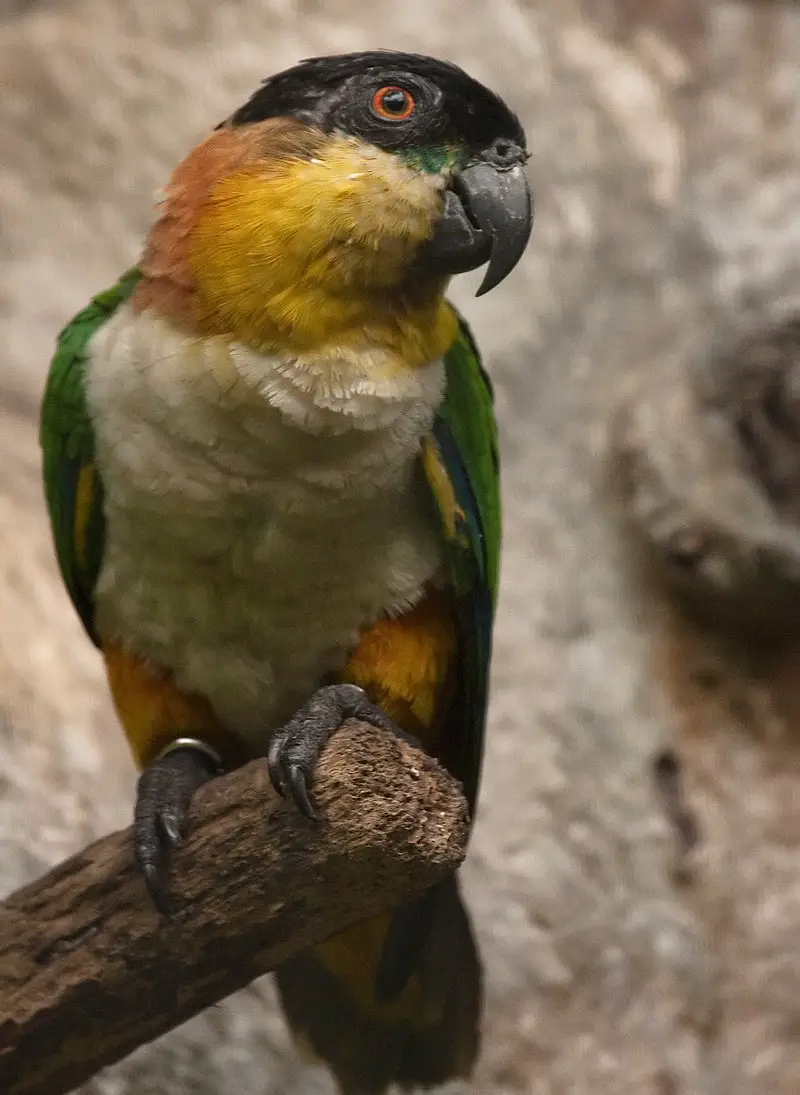
The black-headed parrot, also known as the black-capped parrot, is a species of bird belonging to the family Psittacidae. This parrot is found in Brazil, Colombia, Ecuador, and French Guiana.
They are known for their black head and crown, which contrasts with their bright green body. They are a popular pet bird due to their playful and social nature.
The black-headed parrot is also sometimes inaccurately referred to as the black-headed caique.
They are a medium-sized parrot and feed on a diet of fruits, seeds, and nuts. They are capable of mimicking human speech and are often trained for this purpose.
This species of parrot has a subspecies known as P. m. pallidus, or the pallid caique.
Overall, the black-headed parrot is a beautiful and intelligent bird that is beloved by bird enthusiasts around the world.Scientific classification:
| Kingdom | Animalia |
| Phylum | Chordata |
| Class | Aves |
| Order | Psittaciformes |
| Family | Psittacidae |
| Genus | Pionites |
| Species | P. melanocephalus |
51. Lord Derby’s Parakeet
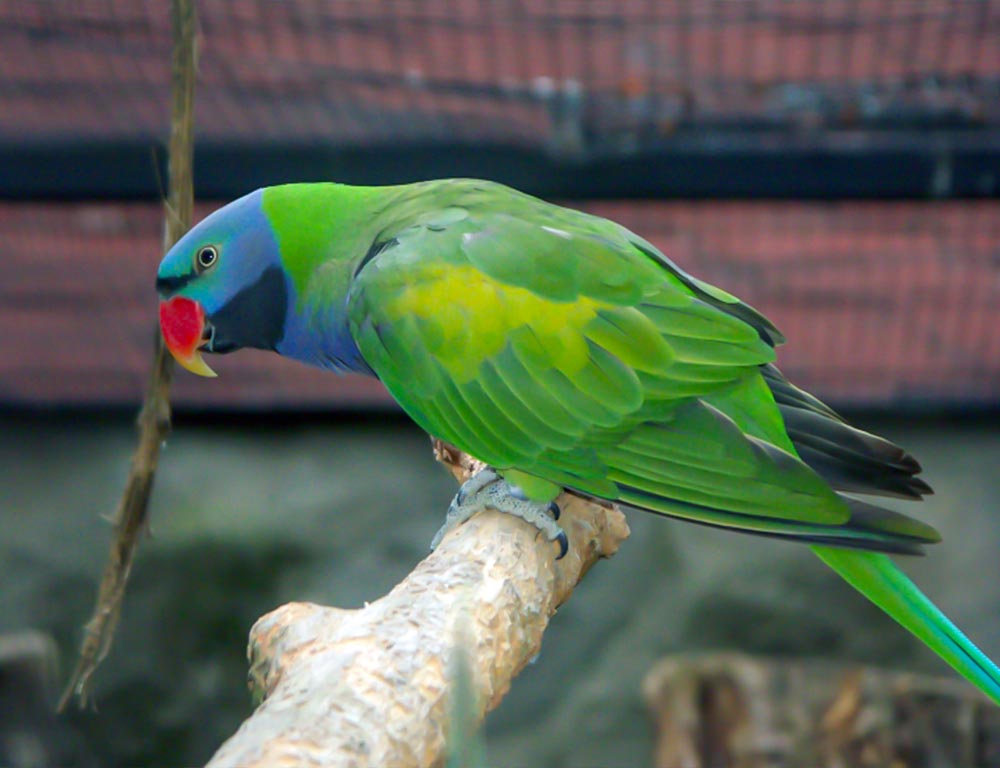
Lord Derby’s parakeet is a beautiful parrot species found in the Indian states of Arunachal Pradesh and Assam, as well as parts of Tibet, Sichuan, and Yunnan in China.
This bird thrives in small pockets of moist evergreen forests but unfortunately faces threats such as the cutting of old trees (which are important for nesting) and poaching for their feathers.
Despite these challenges, Lord Derby’s parakeet is a striking bird to behold, with vibrant green plumage and a distinctive red beak.
Conservation efforts are necessary to protect this species and preserve its unique beauty for generations to come.
Scientific classification:
| Kingdom | Animalia |
| Phylum | Chordata |
| Class | Aves |
| Order | Psittaciformes |
| Family | Psittaculidae |
| Genus | Psittacula |
| Species | P. derbiana |